|
Summer 2008 I went again for a rather
big bunkertour, this time I went to see France and Belgium. First
I wanted to visit the former battlefields around Ypres, which are
mostly and in a sad way known for being the first locations
to endure chemical warfare. But I also wanted to go see the
battlefield of the Somme, thus having seen all the major
battlesites on the western front of the first world war, since I
had been to Verdun already. And as a bonus I would then go to see
the V-weapon bunkers around Pas-de-Calasi where V1, V2 and V3 can
alle be seen. Should be very interesting to see those massive
overground constructions. So this was the raw idea on what I would
try to see that july.
Ypres
I went alone this time and for the first day I was heading towards
Ypres, a city in Belgium. This time I was well prepared with maps
frmo Google and a freshly programmed GPS unit including western
europe as a complete map. Should make navigating much faster and
easier. I also brought along much more equipment.(Tent, Selkbag,
electric cooler box, a BBQ grill with air pump and everything). So
the ride was promising to be ok and until Belgium I got through
pretty well. But shortly after stopping for gas in belgium, a
weird stench was inthe car suddenly. Something like burnt
electronics? Smoke came out of the dashboard and then I had to
stop on the roadside - the Y-Adapter to hook up the GPS unit and
the coolerbox at the same time had melted and shorted out a bunch
of fuses and had just caught on fire! I extinguished the mess and
managed to drive to the next gas station and even got fitting
fuses there. Got out the car manual, plugged the fuses in and I
was good to go - but now I had to alternate between charging the
GPS unit and cooling food/drinks and that really sucked. The GPS
unit lasts only a few hours on battery, so this proved to be one
of the problems regarding food and drinks this time...
A few hours later (Belgium has this
120 spped limit...) I arrived at my first stop for the day, the Zonnebeke Museum
in Pahschendaele, which accroding to some reviews on websites I
read should be a good introduction to Ypres and its history.
Beautifully located in a park, it was a bit hard to find since the
roadsigns were sorely lacking. A short walk in the sun later I
found it and around noon I could take the first pictures of my
trip. Due to the little fire incident I was behind my schedule for
about an hour, leaving a few minutes later as planned and the
speed limit in Belgium plus all the radar checks there did
certainly not help either. Anyways...
Größere Kartenansicht
Inside the museum you could see a
rather large variety of dioramas and equipment of all armies.
Right at the beginning the museum showed in a largfe display the
history of gas warfare sround Ypres and how soldiers tried to
protect themselves from it.Im Museum konnte man eine sehr
große Zahl an Dioramen und Ausrüstungsgegenständen de
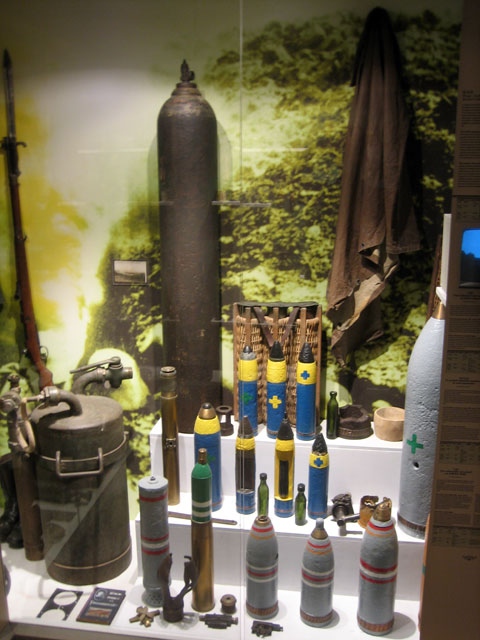
(Gasgrenades, gas cylinders and equipment.)

(Gasprotection by simple and then more elaborate gas masks.)
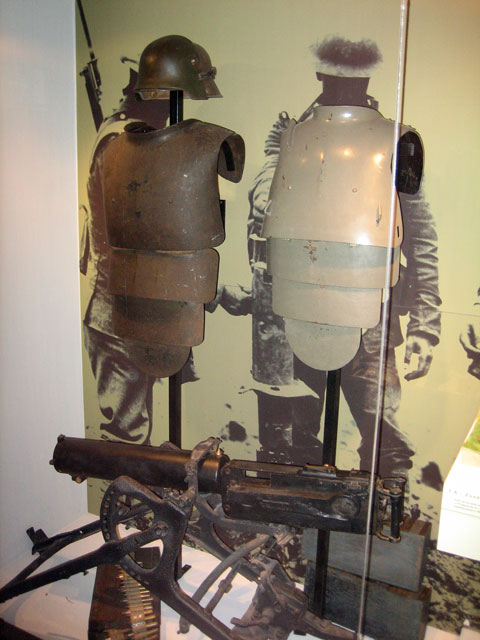
(Bizarre: Medieavl lokking body armor for trench warfare.)
The
basement level of the surprisingly huge house contained a
reconstructed tunnel system similar to the ones actually used
during the war. Even today they still find occasionally during
construction of houses etc. old tunnels which were dug from both
sides during the war. In some places craters suddenly open up if a
dugout or old bunker gives way, causing houses to collapse and
even cars to disappear in the ground! The exhibition is really
well done, using sound effects and ambient lighting. There wer not
too many things on display in the tunnels, but it was done
effetively and quite nice, a good idea on how it might have looked
like. A bit too sterile and clean for my taste, since I saw the
tunnels of Vauquois before but I guess this is ok. 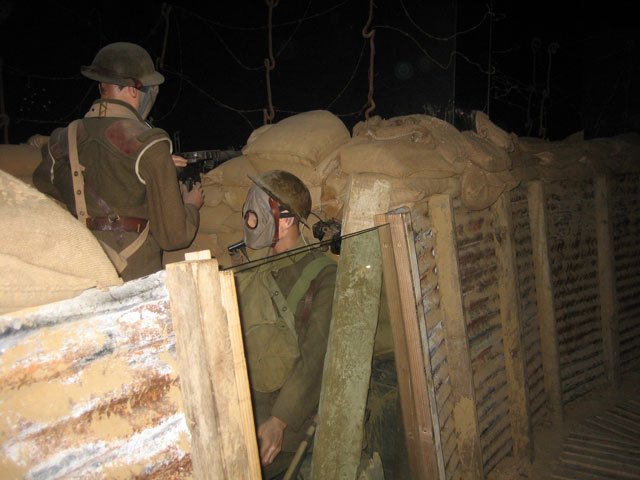
(Reconstructed tunnels in the basement)
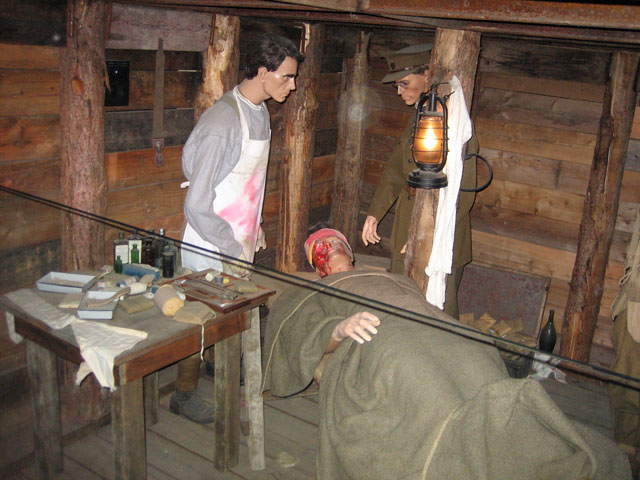
(reconstruction of a hospital)
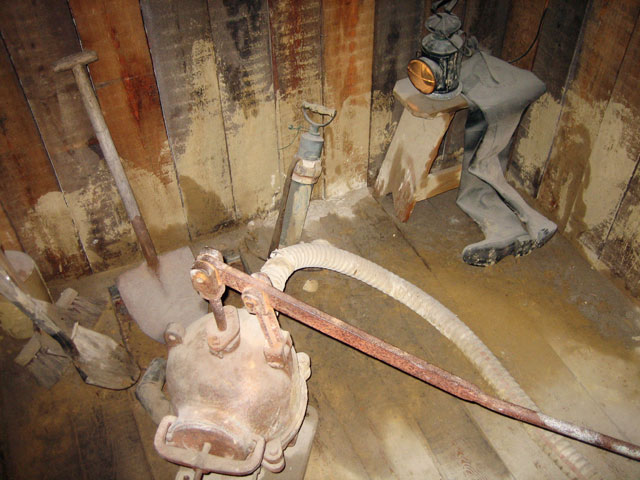
(Waterpump illustrating the problems with flooding in the tunnels.)
It
took a little more then an hour to see the musuem and I wished I
could have spend a bit more tiome there since its setup as really
nice, but this just didn't work out. I had a too tight schedule
planned unfortunately... My
next stop was the Hooge Crater, including a small museum
next to it. Arriving there I was unabel to see the crater itself,
it looked as if it was turned into a cemetary - so I just checked
out the museum. Later on back at home I found out that the crater
is in fact way behind the museum and that it was just missing the
signs pointing to it. Bummer.
Größere Kartenansicht I
checked out the museum briefly. It is located in a former church
and is surprisingly small. However it is really packed from floor
to ceiling with militaria. But this was the best showcase that
quantitiy does not equal quality. Seriosuly: I don'thave to see
200 different kinds of handgrenades which might all be in perfect
condition - I'd rather see a variety of things and a broader
spectrum of showcases. So my visit here was recordbreaking short,
less then half an hour and this is basically all the time you
might want to spend here. The good thing was of course that I came
back closer to my planned schedule, so that was a plus. 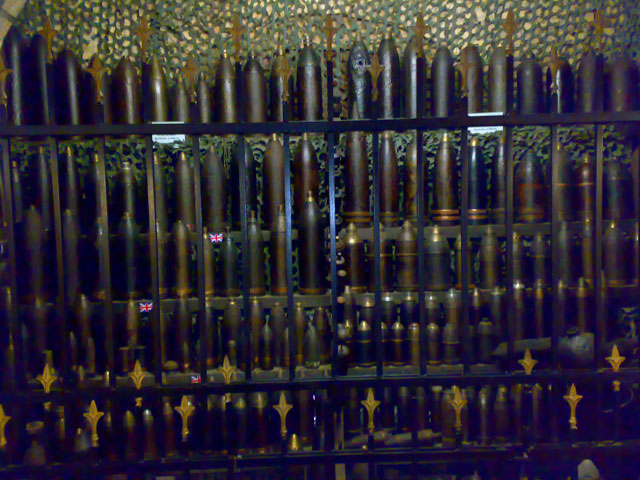
(Grenades as far as you can see.)
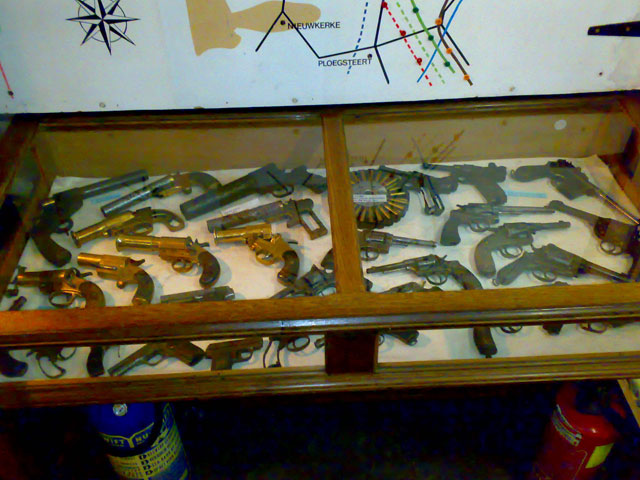
(Dozens of pistols and revolvers.)
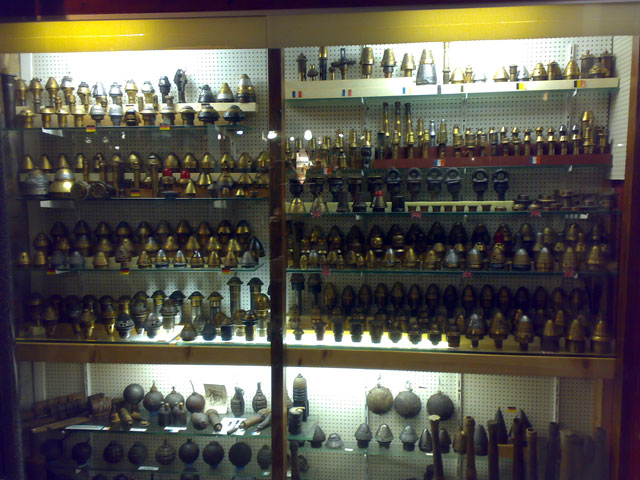
(Again lots of grenades and fuses.)
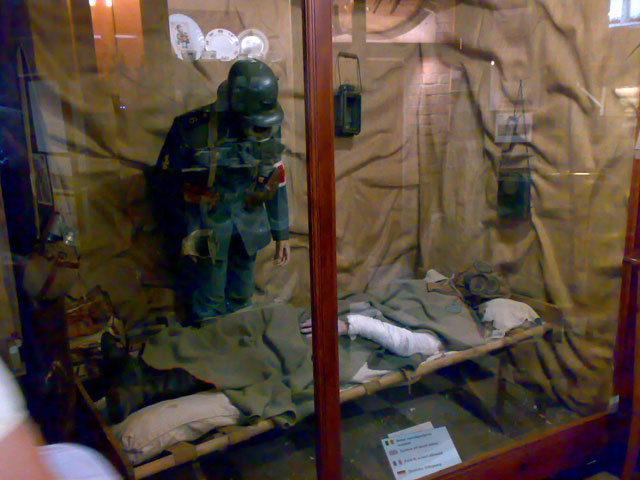
(The dioramas were covered with highly reflective glass
unfortunately.)
The afternoon
was approaching fast and I needed a little snack. So I ate a
little something - but preferred to eat stuff I brought along.
Prices in the cafe were not really to my taste. A few minutes
later I continued my tour and visited "Sanctuary
Wood", where german and canadian troops were besieging
each other for years at end.
Größere Kartenansicht A
rather large part of the trench system was kept in really good
condition and unlike at Verdun wasn't covered in grass. No, at
this site there was still just mud, wood, naked earth and rusty
metal on the ground, looking much more recent and authentic then
the trenches at Verdun etc. Unfortunately there were two english
schoolclasses arriving with me as well and that was a bit sad to
see, since they paid no respect to anything on site. On the other
hand I wasn't that interested in history at that age myself, so
who knows if I wouödn't have been bored as well? Regardless it
took away quite a bit of the experience of visiting this site with
it swarming full of kids. Pity. 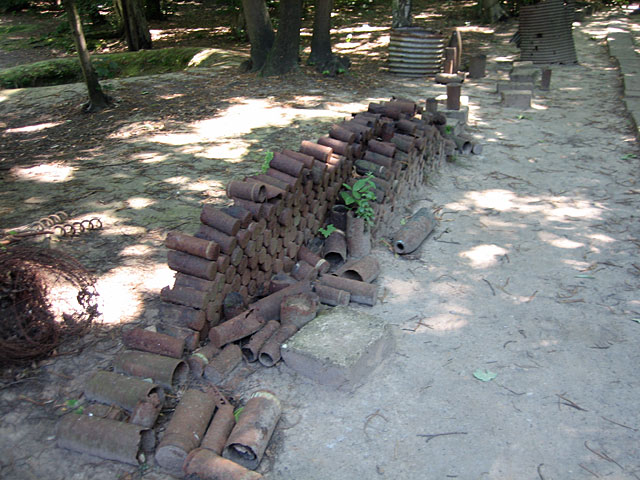
(Ammunition rests, continually recovered when taking care of the
site.)
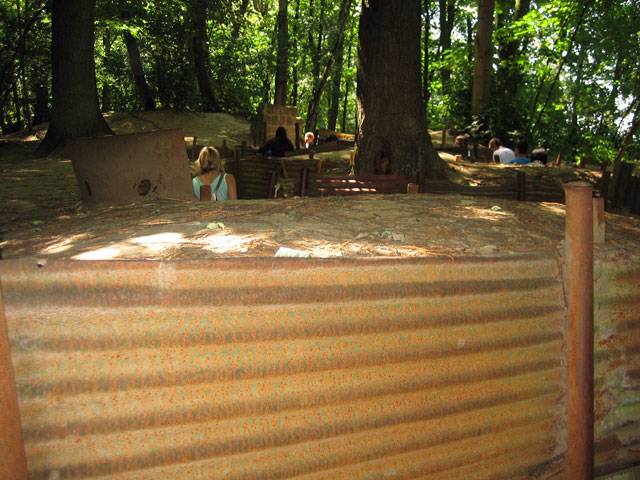
(English schoolclass ahead in the trenches.)
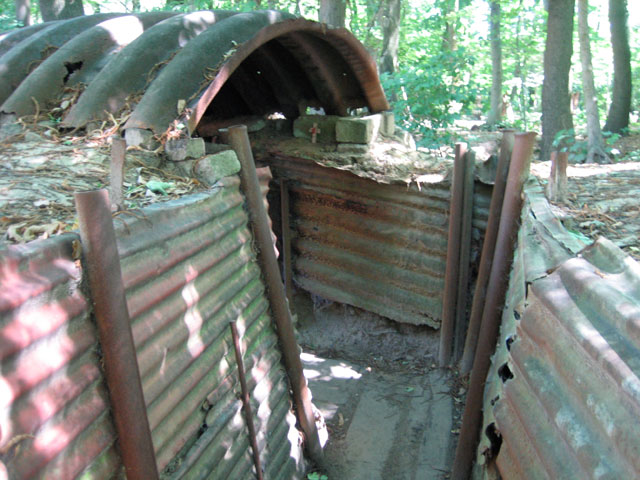
(View of the trench.)
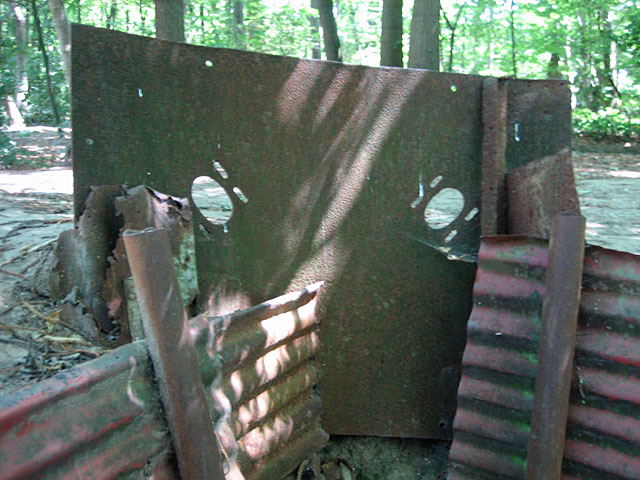
(A trench shield providing cover for observation purposes.)
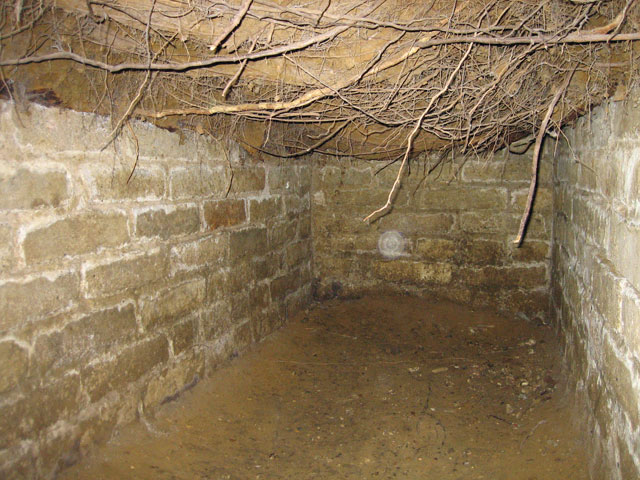
(A tiny bunker from the inside.)
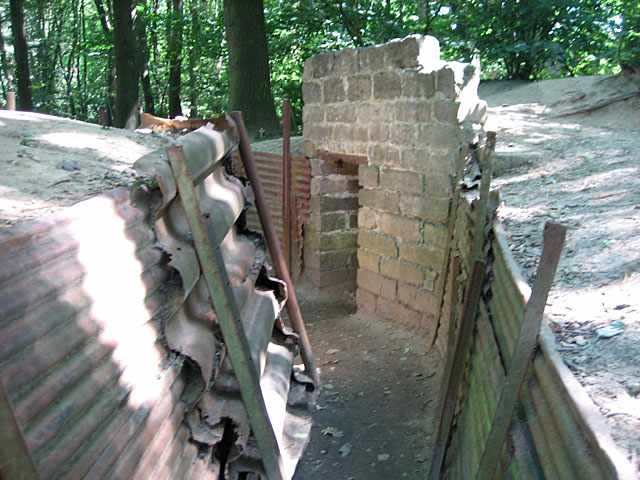
(Entrance to the bunker.)
At
times it was very muddy in the trenches and I forgot my "mud
shoes" in the car, so waering sneakers it was quite nasty to
get through the whole system. I had to take some detours to be
able to see everything. 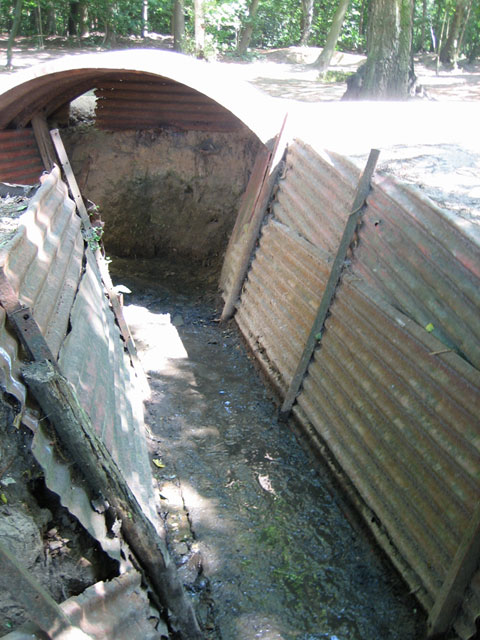
(Muddy trench.)
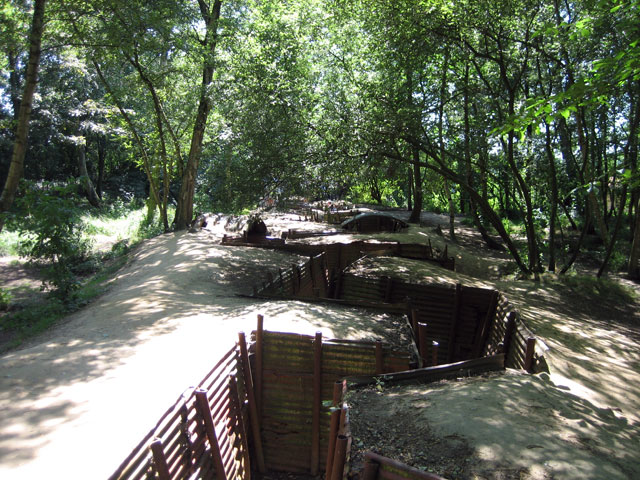
(Zigzagging trenches.)
I
spent quite some time exploring the trench system, following that
I checked out the museum that is attached to it. It resembled more
a militaria store, a memorial and storage closet then a real
museum so I cut my visit short. Also it wasn't that fascinating,
and the schoolkids were swarming all over it as well. If they
wouldn't have been around, Sanctuary Wood would have been quite
great to see. Still: More impressive then Froideterre, and
definitely better kept.It lacks a bit the piety of the Verdun
sites though. 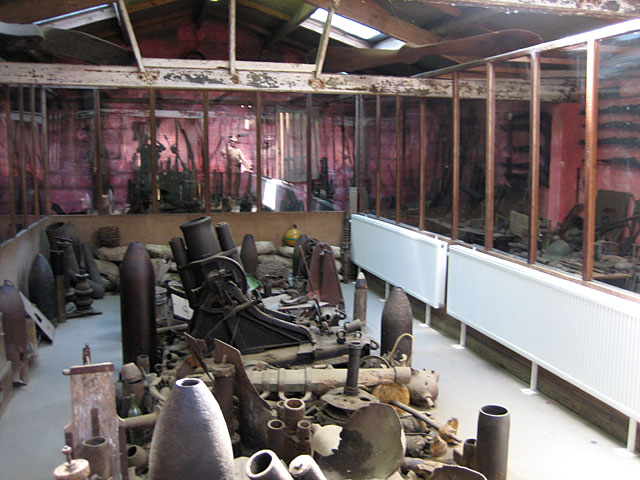
(Storage room like exhibition in the "museum".)
I
left Sanctuary Wood then and dried my shoes in the car as much as
possible. My next stop for the day would be Hill 60, which
is not too far away from here..
Größere Kartenansicht Hill
60 is a man-made result of spoil from a nearby railway cutting in
the nineteenth century which is no longer present. One of
the only sloghtly higher points in the flat landscape, it was the
scene of bitter fighting to get above the muddy ground. Arriving
there I first noticed that the museums cafe that was supposedly
freshly renovated and open - had closed down. And the museum
itself is now completely gone - if this is unfortunate or not is
left to decide. I peeked through its windows but did not see
anything interesting. So I went to explore the small hill. I
parked the car and went up on the hill to see what was left there. 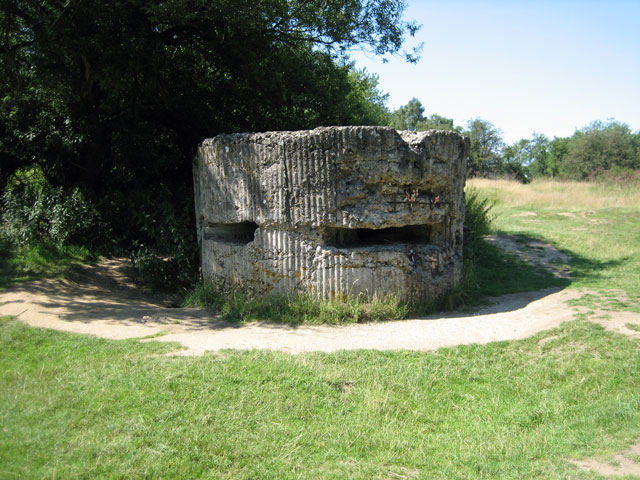
(Pillbox bunker at Hill 60)
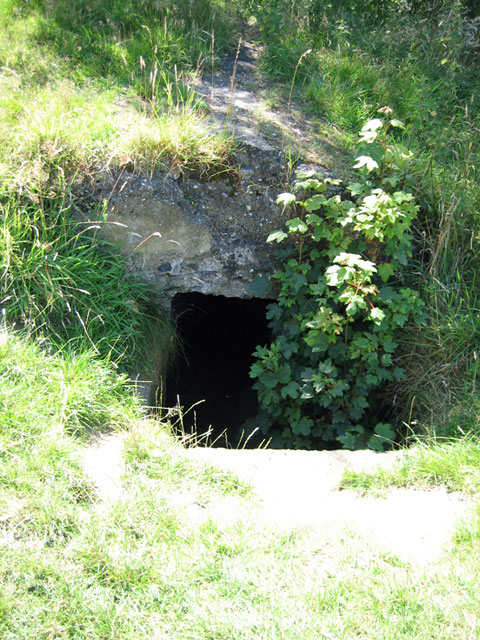
(Small concrete dugout.)
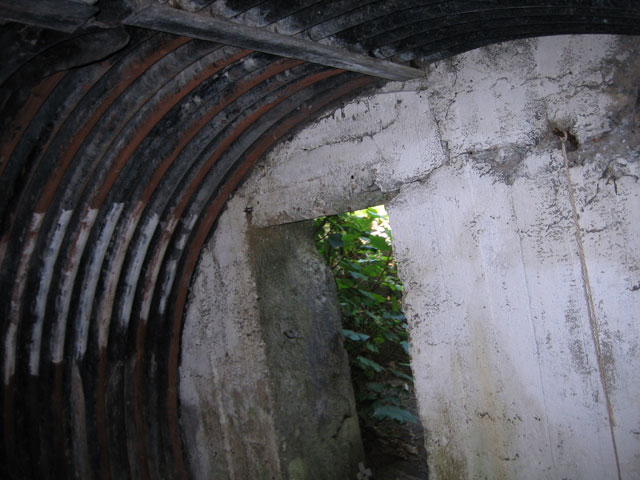
(I squeezed myself in and tried to take pictures - way too small
for that. Can hold 3 persons max I would say.)
On
my way back to the car I saw a huge crater that was created by one
of the british mines that were exploded here during the battle of
Messines. It took a part of the german front trench with it as
well as a significant amount of the hill. Simply gone! 
(Mine crater with a small metal cupola of unknown origin. Looks
like an observation cloche.)
On
the hill I saw a small british travel group that were
investigating the hill. When I went back to my car, I dicovered
thanks to the writing on their van that they were from Battlefieldtours.co.uk
whose website I used as guidance for my trip planning. Nice
coincidence! Two friendly dutch ladies wanted to know some details
about this hill from e as well there, so we had a short chat about
it and I could tell them a bit about it. They were bit
surprised at the end that I was not an american as they though,
once they saw my german license plate on the car... Nice. :) Following
my experiences on the hill I went on a somewhat confused journey
to find the "Bayernwald", which contains a small
trench system and some bunkers. Some decades ago a school teacher
bought the lot and discovered an old mineshaft on the property. He
started to excavate the area and found several bunkers, remains of
trenches and some mineshafts, turned the whole thing then in a
small museum. Unfortunately when he died the thing fell in
disrepair and was closed down - but recently it was all renovated
and reopened. But to get there, you have to get an unlock code for
the gate that you get at a tourist office in a small city some 15
minutes away. Not easy, but doable.
Größere Kartenansicht
The situation on site was not the
best as I discovered - there were new tables showing what this
place was about but a part of the site is fenced off due to it not
being repaired yet. It is also quite obvious that the original
owner had a slightly "down to earth"-attitude when it
came to reconstructiong the site. In a lot of places it looked as
if there was notm uch original stuff left besides the bunkers, but..
it is better then nothing. The local tourism office is thought
trying to get the small site back to a rather decent standard.
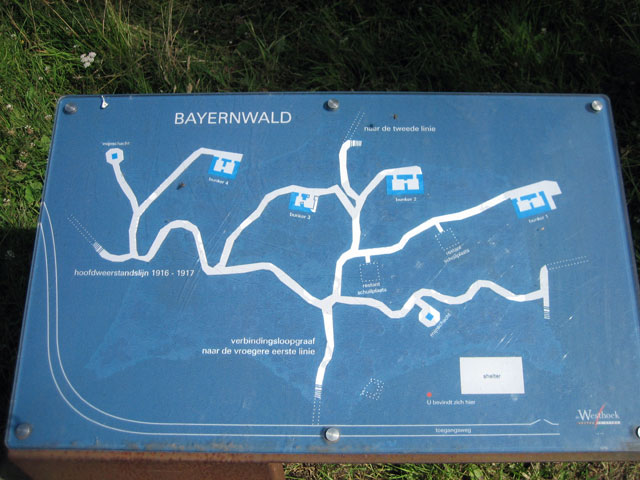
(trenchsystem at Byernwald - the area left of
"1916-1917" is currently inaccessible.)
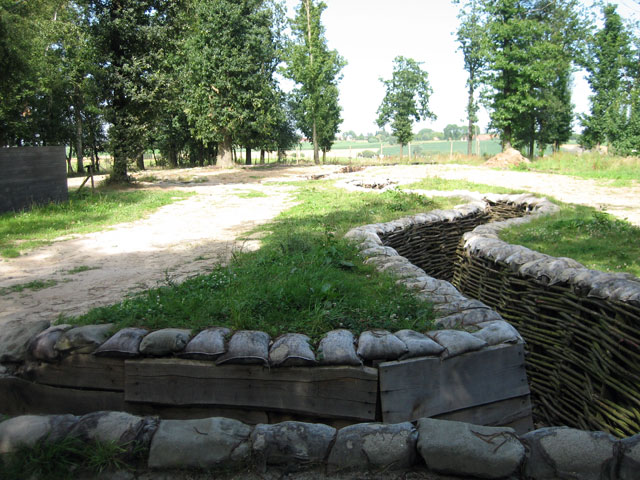
(View of the first half of the trenches. Not that big.)
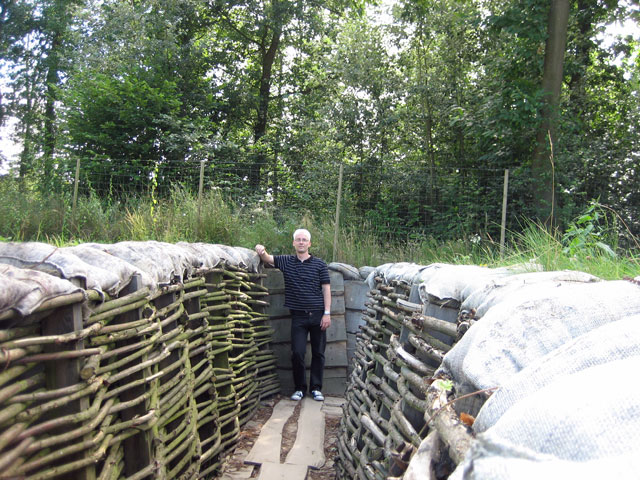
(To show the size of the trenches: Picture with me in it.
Trenchwalls were covered with wooden panels and fascines.)
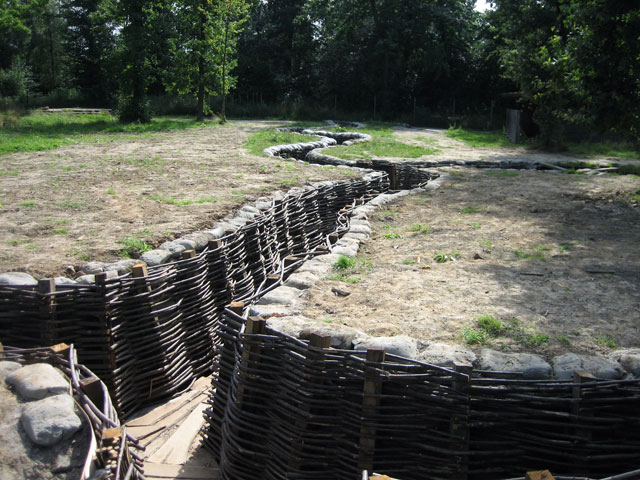
(Teh other half of the trenches.)
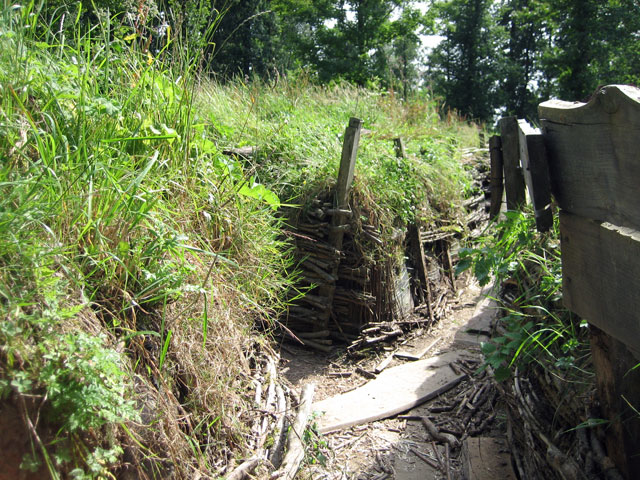
(Decaying trench.)

(Entrance to the small german Bunker.)
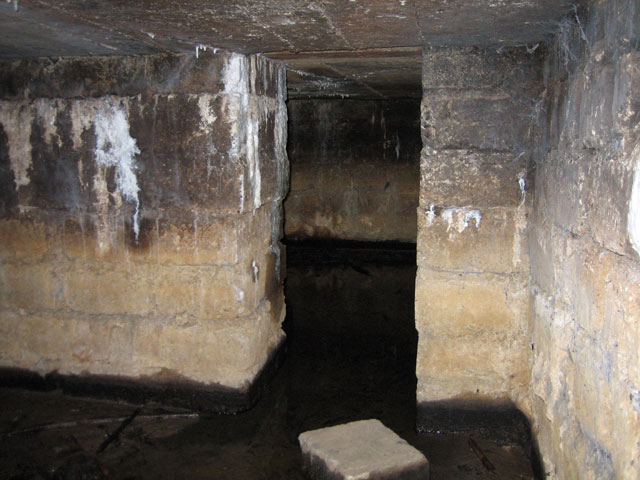
(Inside the bunker, extremely simplistic setup, two rooms with
connecting door. Full of water and trash. Sad sight.)
The bunkers were built so small
intentionally to make them less likely to be used permanently. The
inhumane logic was that this would otherwise cause soldiers to get
too comfortable and decrease their morale to fight. Completely
insane....
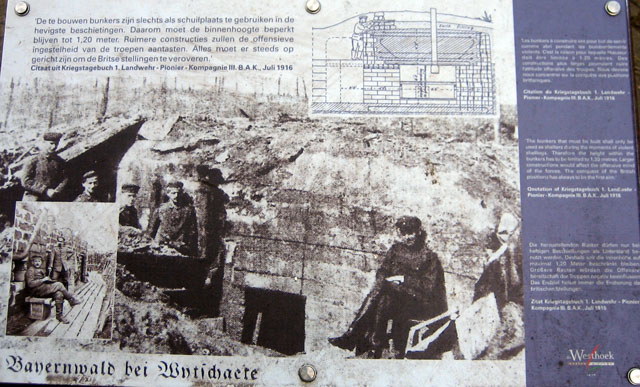
(Picture with (presumalby) Hitler in it at Bayernwald.)
One of the reasons Bayernwald is a
bit known: Hitler served part of his service in the first world
war here as a messenger. I would have appreciated it, if he had
stayed here "permanently", but no... :/

(Better view of the bunker form the outside - notice how small
they are!)
Since there wasn't
so much else to see here and the mosquitos were bugging me quite a
lot now, I left for my next target for the day, a museum in Ypern, "Cloth Hall".
Upon arriving there I noticed though that you have to be there at
4:30PM latest to gain entrance. Obviously they cut down opening
hours recently and did not update their website. Pity. So due to
my problem on the drive through Belgium I was too late to see it -
well, not everything works out always. So instead I went on to get
to the camping ground and set up my tent. That in itself was
another adventure. Back when I did the trip, Google
Maps had a horrible resolution of Ypres, so you couldn't see
exactly where the camping ground was. And the adress given is
technically correct - but to get to the cmaoing ground, you need
to come from the other side of the whole block and that is not
really obvious if you come from the city center. But a short visit
at the local swimming pool and some french/dutch/english later I
knew where to go.
Größere Kartenansicht At
around 6PM I managed to arrive at the camping lot and checked in.
The young couple in the booth was a bit surprised to find a german
with some dutch skills asking them about his reservation and were
rather pleased about it. Nice. So I went in with the car, parked,
got the tent out and set it up in short time, set up everything
else - and then decided to skip the optional visits for today. I
had thought about going to a small trenchsystem nearby that had
been taped for a british TV-Show and also a small bunker at Zandvoorde,
but figured this should be enough for today. Only the evening
ceremnoy at the Mening Gat in the city centre would be my last
thing for today. The local firebrigade is blowing their horns
there every evening in memory of the allied soldiers that defended
this city in the first world war, making it the only major city in
Belgium not occupied by the german army. The walkway there led me
through some fields with grazing cows and across the mediaval moat
around the city. A very nice and pittoresque view. 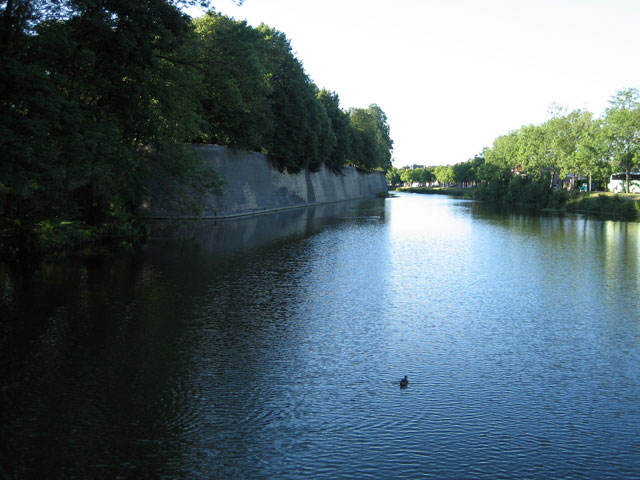
(City wall and moat.)
Arriving
at the gate I "saw" this ceremony, surrounded by
hundreds of british tourists. I thought it was a bit weird, but
everony else loved it. Oh well. 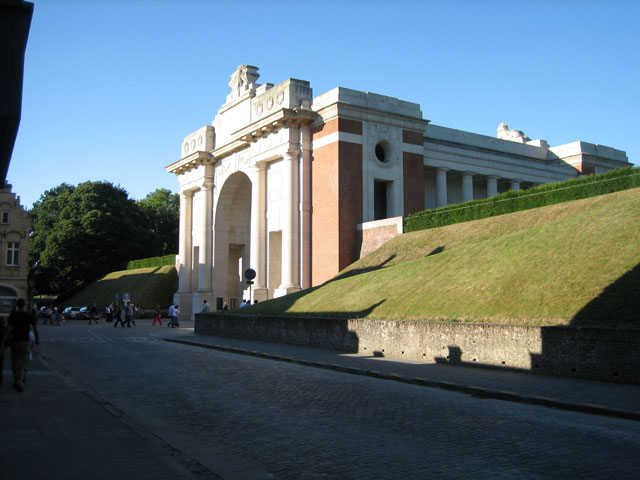
(The Mening Gate where the ceremony is held.)
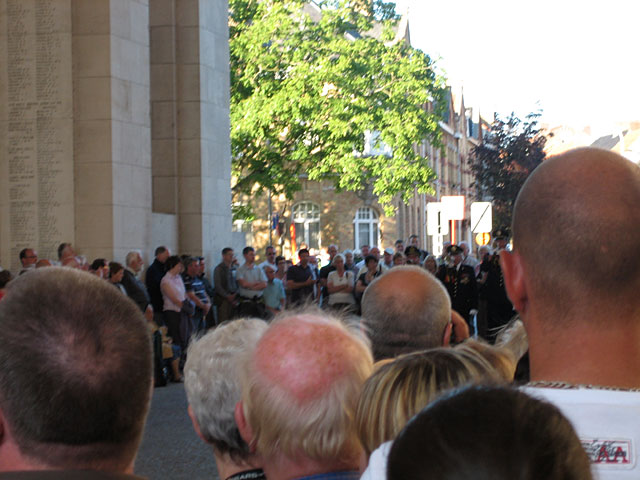
(My view on the ceremony, hornblowers in the back right.)
Followng
this I went back to the camping ground, opened up a beer, set up
my BBQ and then griled some food. Opposite of me was a quite
british family of five, who were a tad bit weirded out by my
preparations: electric pumnp for my air mattress and to fire up
the grill faster, a nice chair to hang out in, a big tent for just
one person, the BBQ, a cold beer from the electric cooler, my big
camping blanket as a nice place to hang out and eat - and a really
great dinner. I brought some good quality steaks with me, had
tomatoes, radishes, a fresh garlic baguette and some hardboiled
egg: What else did I want? When I was finished with eating, I flew
my X-Twin for a while on the parking lot, which was also fun.
Called Tia afterwards to report back and tell her that I was doing
well and that everythign is alright. Then finished the day in
front of the grill, having another beer, finally put out the
flames and went to sleep. The next day would be long and packed
with stuff to see. The camping lot was definitely decent and quite
nice, not too big, completely underrated in my opinion: Thumbs up! 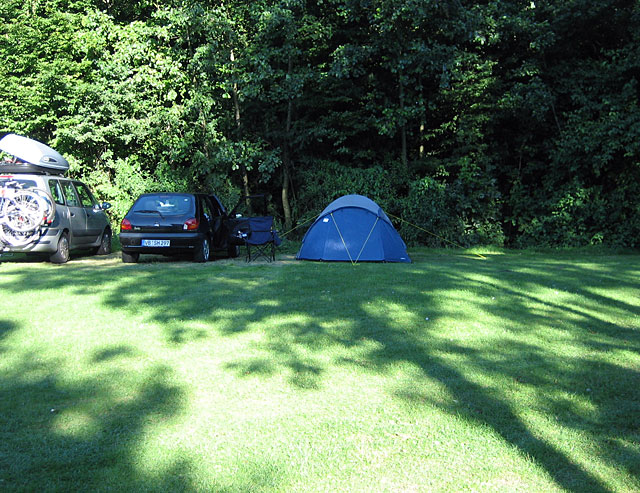
(Camping in Ypres.)
Somme Next
morning, and I was a bit sleepy, but rather well rested from the
night. Thanks to the new sleeping bag that Tioa got me, fitting
clothing and the insulated blanket under the mattress, I spent the
night inthe night under rather good circumstances. Went to do my
mrongin routine at the bathrooms, which were not the most mordern
ones, but clean and functional. Then I put my valuables back in
the car, put away most stuff on the camping ground and left for
the day. Picked up some gas, got some coffee, programmed the GPS
unit and off I was to the Somme on the highways. And just like the
day before, the speed limits were annoying, it took quite a while
to get to France, and with 120 in Belgium and 130 in France it
just takes so much longer to get to places... Speeding is not
recommended, I saw a bunch of cameras and radar traps on the way.
The ride was ok, but the exact street I needed to go t was not in
the GPS unit, so the last few miles were an adventure. The french
aren't that great on setting up road signs either, so this was a
bit annoying. Thus it took me a bit longer then planned to arrive.
By this time I was also quite fed up with plugging in and out the
GPS unit as well as the freezer box, either my food might spoil
due to the higher temps that day, or my GPS would run out of juice
and I would get lost. Tragic. First
stop of the day was the "New Foundland Park"
between Hamel and Auchonvillers. A regiment from Newfoundland
tried to make its way back then on the first day of the Somme and
was practically eradicated by them. A traumatic experience for the
small population of Newfoundland back then, almost every family
there lost a member that day here. Insanely enough the
Newflundland troops were sent out ill-advised against very well
dug in german positions. Weeks of fighting later, they only
managed to conquer a few hundred meters. Insane.
Größere Kartenansicht The
terrain and its state resembles Douaumont at Verdun, just like
there gras has been growing over the pockmarked trenches and makes
the barren land look much nicer. Also turning it into some modern,
bizarre and morbid kind of botanical garden. 
(Gardeners at work, standing in the second line at the
Newfoundland side. Behind the street was the third, reserve trench
and a field hospital .)
At
the entrance a french family passed by the freindly canadian
student, who was onduty today to show tourists around. I started
using french with him, but we quickly changed to english as this
was easier for both of us. Like me back then he was studying
political science, so taking the tour with him was extremely
exciting. Since I arrived early, I was givnen the tour all by
myself, great thing. It was even cost-free, but I donated a 10 in
their box, this was by far the best tour I ever got anywhere.
Awesome, qualified and dedicated. He was also quite interested in
my other tours and what my motivation was to check out this place.
They don't get many german tourists there apparently. We
began the tour around the area and my guide explained to me, that
we would see both sides of the trenches, since the whole
battlefield was left like this after the war. It was very easy to
see where the trenches had been, the connections to the back and
also where bigger dougouts were. They even marked things like this
on the parking lot, great idea!) A little while later we climed a
small artifical hill on which a monument for the Newfoundlands has
been built. Complete with a roaring moose on top, but things could
be worse of course. 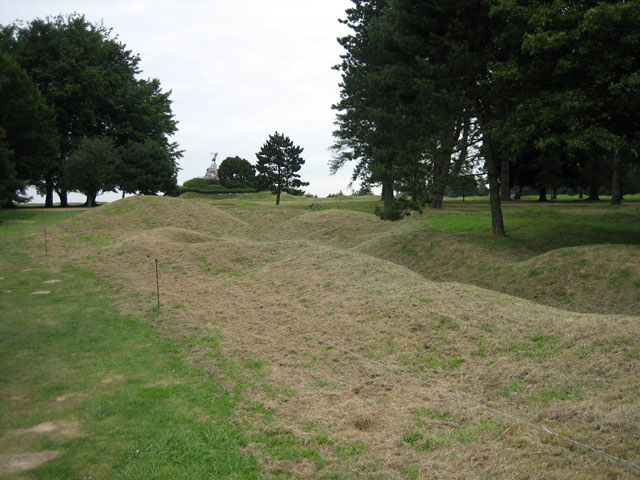
(The monument with the mosse on top. Trenches in the foreground.)
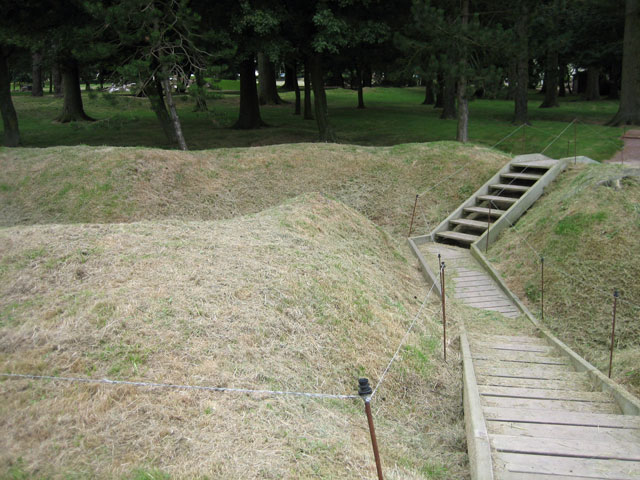
(All walk ways were fenced into keep the landscape as is.Not as
nice as in Verdun, but since the whole site is considered a
memorial, kind of agreeable.)

(Overgrown trenches.)
When we
were atop of the hill, we had an incredible view over the
battlefield. It was easy to see where the german and newfoundland
trenches were and why this battle was so insane. The canadians had
to run down a hill into the german lines, being a perfect target
against the horizon - and the german lines were slightly elevated
again, giving them plenty of opportunity to kill the soldiers.
Whoever had to rise up here, was sure to be shot down. It was
completely fruitless to start an attack in such a place under such
conditions - but it was done anyways. The detonation of a huge
mine under the german lines in close vicinity was planned to make
the attack easier, but it went off too far away from here and
alerted the germans of the imminent attack. 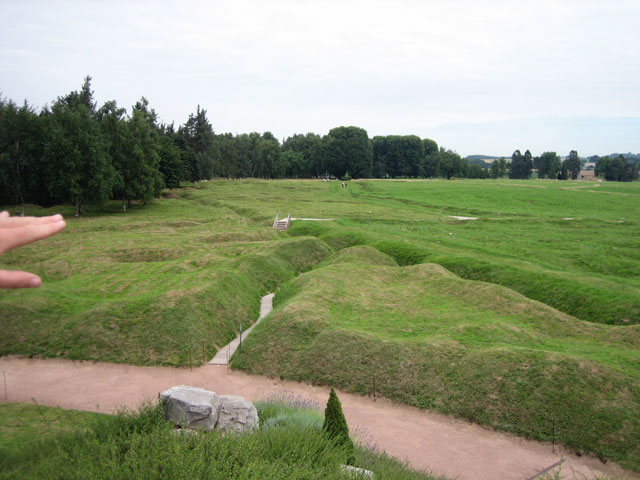
(Neufoundland front trench, seen from the hill. In front of it a
shallow trench that was dug days into the battle.)
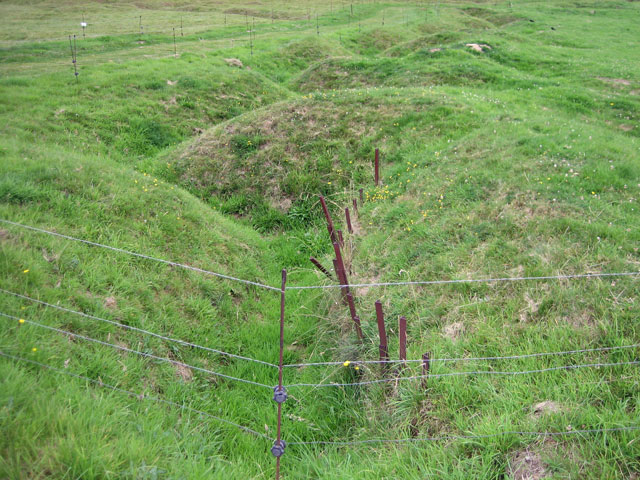
(Relis of the trench walls on the way to the german side.)
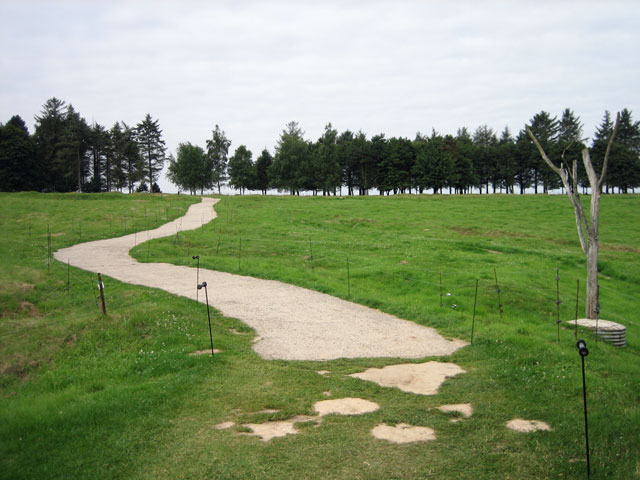
(The dead tree inthe middle of the battle side, also known as "Danger Tree".)
The
attack came until this tree and then stopped here. It is obvious
what short distance this was - every yard of ground that has been
taken was paid with many lives. Complete and utter idiocy. Arriving
at the german side, it was easy to tell that the german trenches
were dug much deeper and with big dugouts, sheltering the german
troops during the artiellery attack. The student guide kept
mentioning, that the germans set up extremely elaborate and well
defended positions here, even giving up the hilltop to have a
better field of fire. Might have been, gruesome nevertheless. 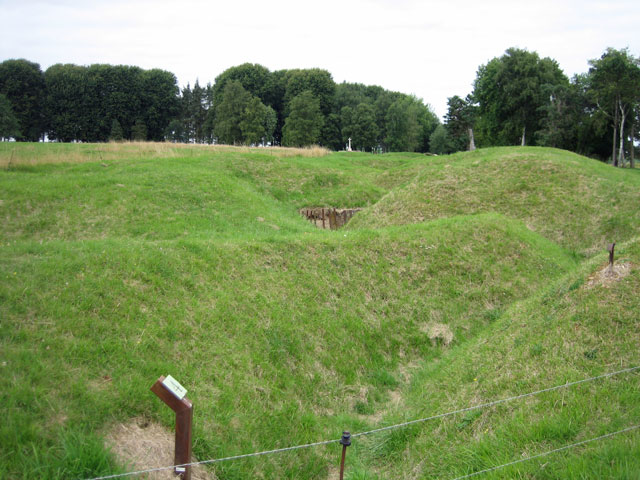
(German trench with concrete reinforcements.)
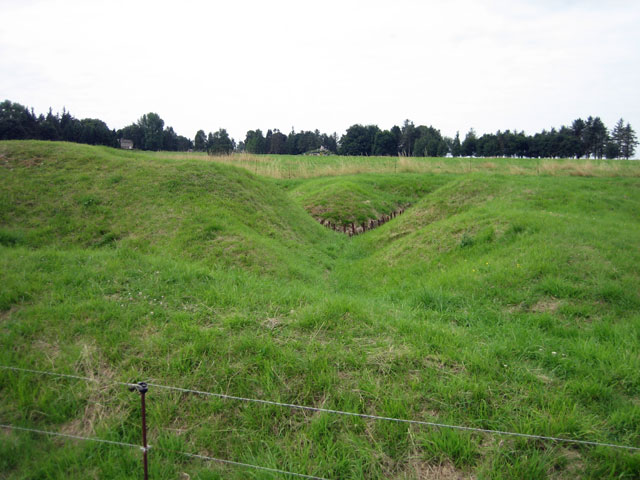
(Free field of fire against the top of the hill - anything that
rises up there is seen excellently against the horizon.)
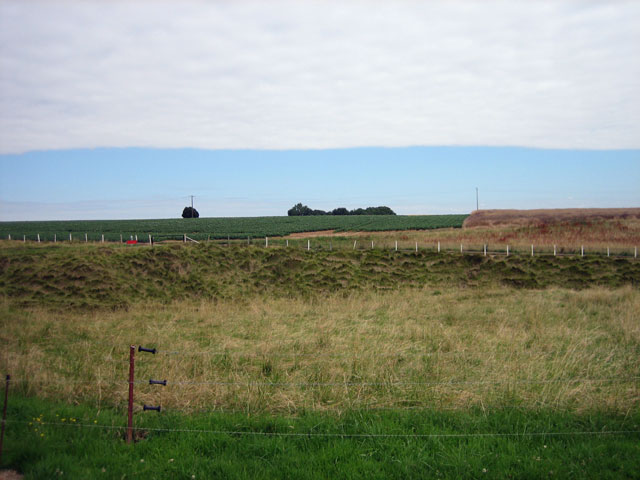
(Where the trees are now, one of the biggest mines ever was blown
up.)

(As a comparison: This was the mine and what it looks like after.)
We
went a bit further to a small vallwey that the germans held as a
place to retreat to and to keep reserves. During the battle the
canadians went through at some point, circumventing this valley
where some germans held out for a few days longer in hiding. They
gave up after a while though. Bizarre detail. 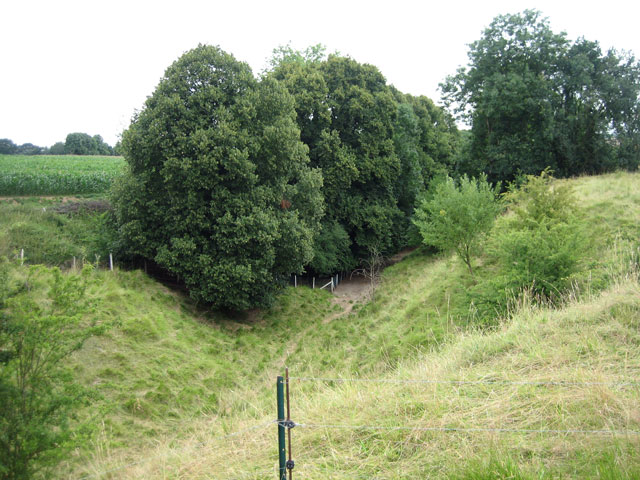
(The small valley.)
We ended
the tour at this point. Honestly: Besides the trenches there is
not much to see, but getting this awesome tour made it worth a lot
to me. I was excited, went to the visitors centre to use their
(clean and nice) bathrooms and then talked to the students a bit
more. So far the best example that a great presentation makes up
for a lack of items to display. My
next stop was the "Lochnagar"-crater, the biggest
manmade crater in europe. On the first day of the battel of
Messines, two mines were blown up here to create a crater und
collapse the german front trenches. Also to create a small ridge
to give the allied tropps some shelter onthe battlefield.
Unfortunately this is all that it did - further then this the
troops were unable to advance. Just like in the park: A lot of
dead people for very little gained land.
Größere Kartenansicht The
crater is privately owned, but the visit is free. One needs to see
this crater for himself, pictures do not do it justice. It is very
big. Even on video it looks pretty small, but it is not. 
(Panorama view of the crater.)
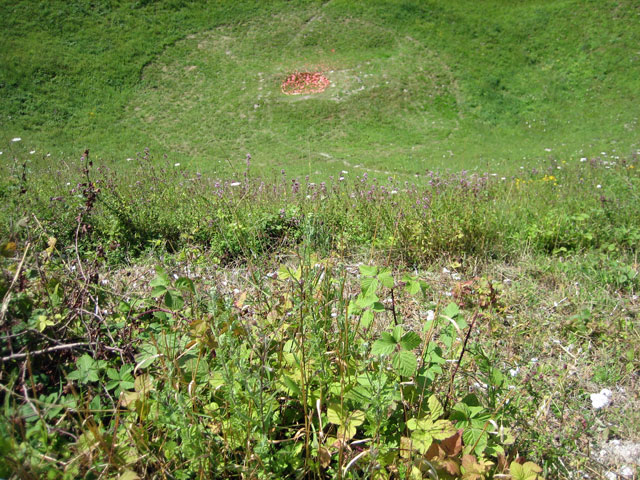
(Detail of the bottom or the crater.)
A
short while later I continued my trip, since there was not too
much to see here. But that was nothing new to me and I knew about
this from the beginning. Next stop whould have been the Thiepval Monument
, which I skipped and rather headed for the Cafe "Le Thommy",
that was reported as having decent food and a small musueum in its
garden. However it was closed that day. So instead I went to Delville
to see the southafrican monument there and have a snack in the car
again.
Größere Kartenansicht This
one was not so great to see - setup by the late Apartheid regime,
this was more a militaristic memorial then anything museumliek or
so. And the battlefield was not kept at all, just all green grass
and flat. Not interesting, I could have skipped this visit easily. 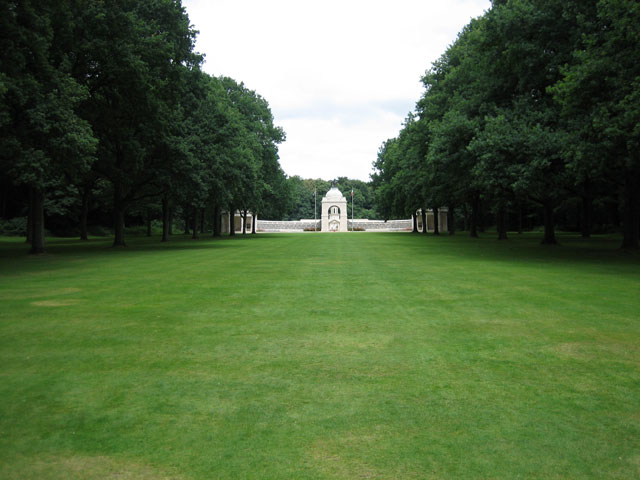
(Southafrican monument at Delville.)
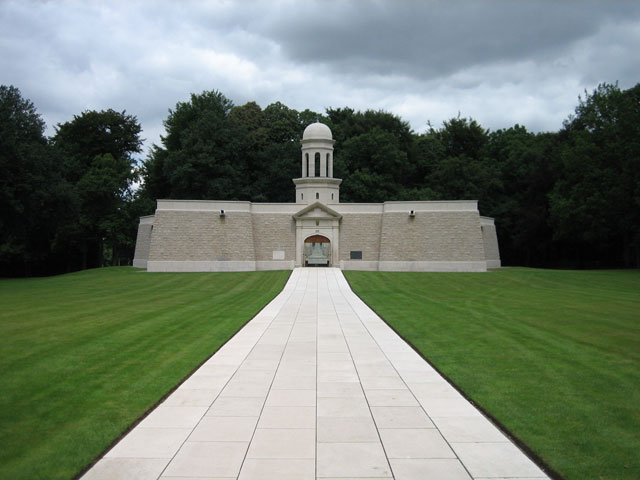
(Teh inner monument with its "museum", erected in the
shape of a fort.)
Inside of
the building was a small exhibition of mostly art - of the
patriotic kind. Thats why I skipped taking pictures, did not like
it at all. I went through it quickly and left again. Only the long
walk to and back from the museum made my visit rather long. I
was a bit hungry now and had the rest of my cold snack for lunch.
Next stop was the city of Albert, a little further away
from the rest of my targets for the day. Here I wanted to see the "Musee des Abris",
which is fittingly located in a former airshelter from the
second world war.
Größere Kartenansicht A
rather interesting idea to locate the museum ther, but it works
very well. Locationswise one of the best I have seen, also a nice
presentation: I liked it. A good movie was shown in a small
theatre in the tunnel, which I could only see for a buit, since I
had few time at hand. But I saw a lot of other pieces on
exhibition, which were mostly used indioramas. A pretty good
presentation! 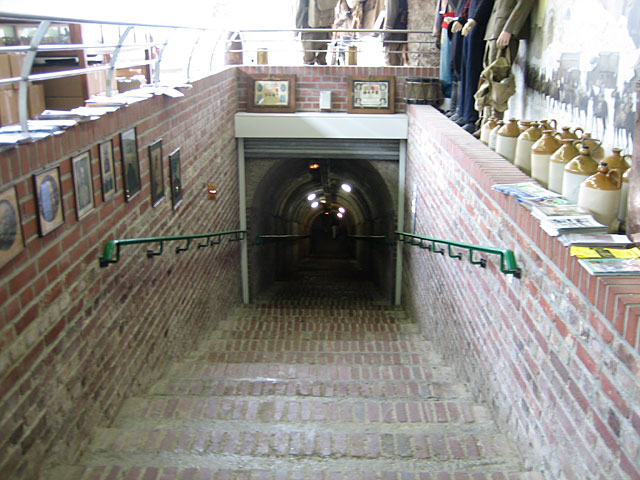
(Entrance to the museum in the shelter.)
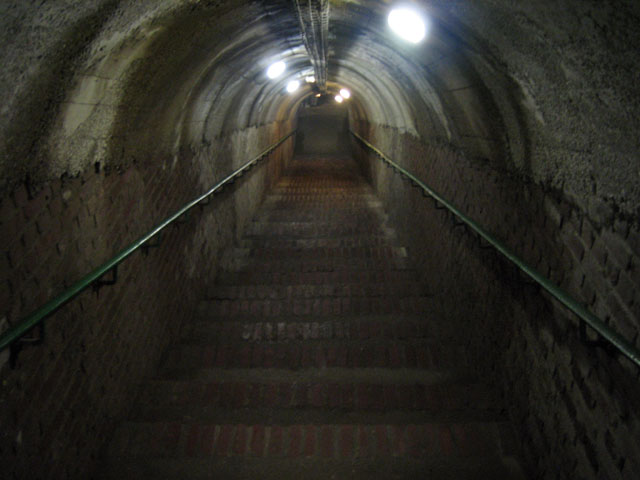
(Looking down the stairs - I felt very protected here...)
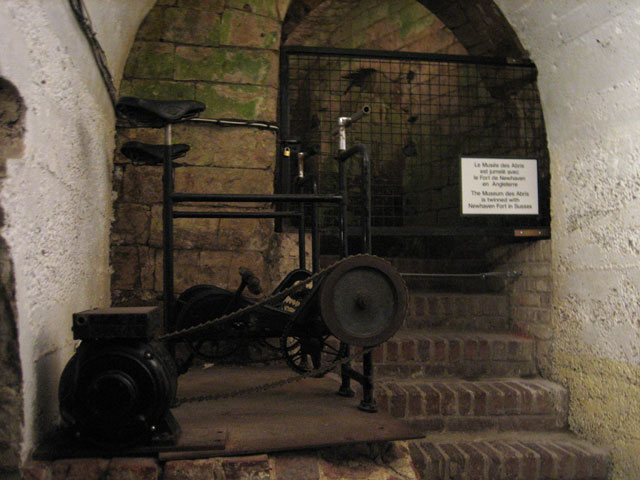
(Pedaldriven airfilters.)
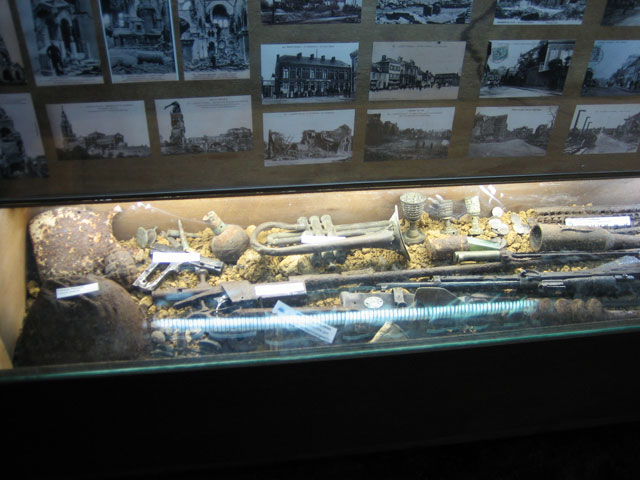
(An example for the vitrines that displayed a lot of interesting
artifacts. Also a lot of old pictures onthe walls, which are
difficult to reproduce on my pictures due to reflective glass and
their size)

(Diorama with gas grenade launcher.)
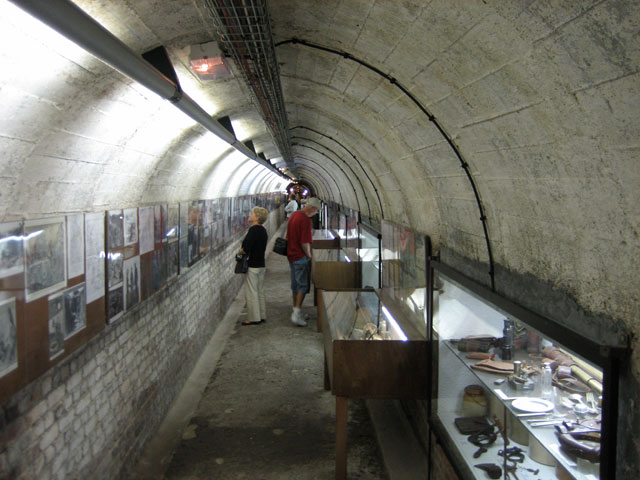
(Scene in the museum tunnel.)

(A rather detailed diorama showing winter.)
All
in all one of the best museums I have ever seen, doen with lots of
attention to detail, set beautifully in place and using its unique
setting to its advantage: Nice. Also a bit of a downing atmosphere,
being in a bunker and all - the museum shop was well stocked and I
was close to buying some souvenirs, but ultimately didn't. I
usually keep to me taking pipctures only. On
my way I stopped unplanned at the "Butte de Warlencourt" -
but besides some rocks and a plate there was really nothing to see
there. A relatively
long ride away from Albert I arrived at "Vimy Ridge",
about half way back to Ypres. Canada is keepinga small part of the
old trenchline in restored condition here, complete with concrete
filled sandbags and a relatively well kept subterranean part of
tunnels. All in all a mix between Vauquois and
Bayerwald, and thats pretty much what it looks like as well.
Größere Kartenansicht Unfortunately
the trenches are "over-restored" so to say. They look
clinically clean. Though their outline follow the original ones, I
have doubtas about them ever looking like this during the war. I
took a few pictures regardless, since the area was well preserved
and easy to access. Unfortuntely the grass was fenced of with
electrical wires, by now I was wondering if this was a canadian
thing... 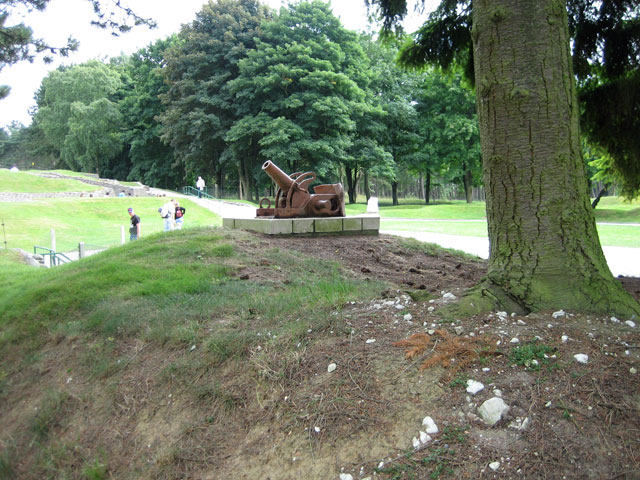
(Mortar at Vimy Ridge.)
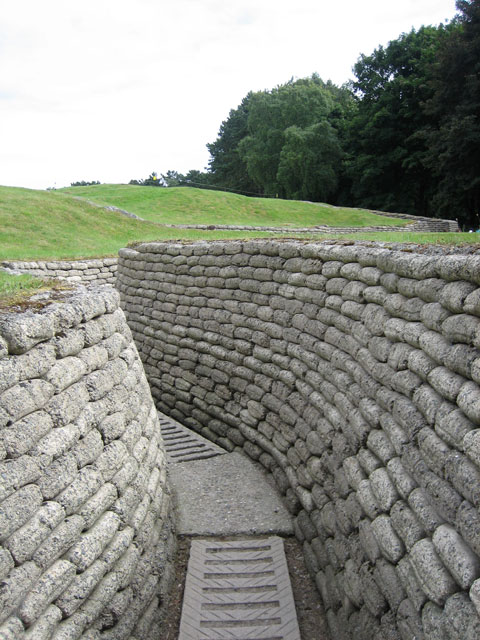
(Typical state of the trenches.)
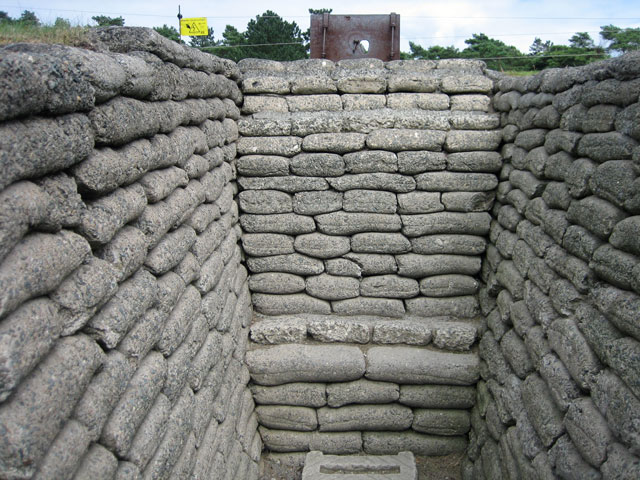
(Trechnarmor at the end of a trench.)
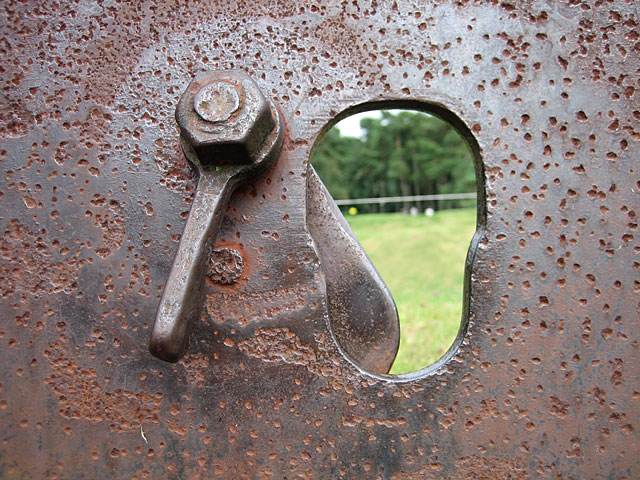
(View through the armored plate.)
I
checked out the area for a while and the bought a ticket at the
entrance hall to access the tunnelsystem below Vimy Ridge. I
managed to get on the last tour for the day, a fe more minutes and
I would have not made it - good planning! We were shown a supply
tunnel, called "Subway", that went from the third line
all the way to the front line to get ammunition and personnel to
the front without being exposed to enemy fire. In addition the
tunnels held hospitals, storage rooms, sleeping rooms and other
facilites. Looked a lot like the french installations at Vauquois
butm ore massivley built and of bigger nature. 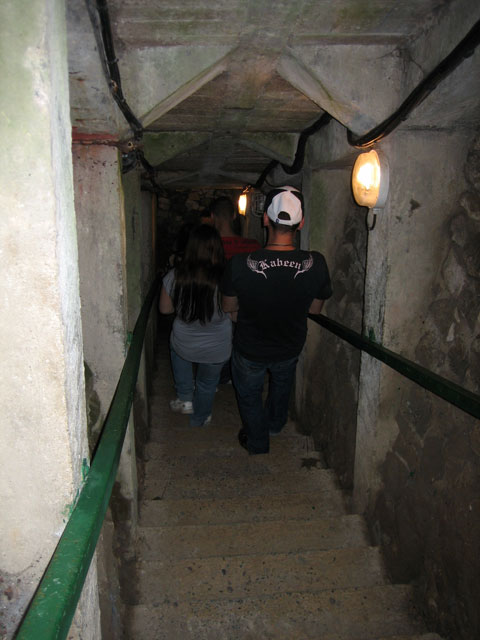
(Climbing down to the tunnels.)
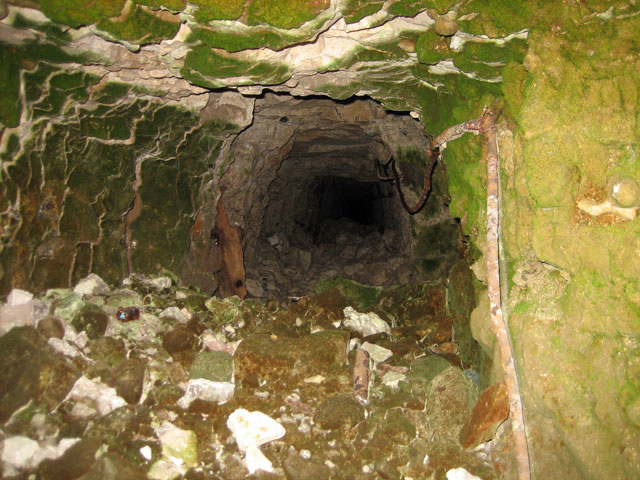
(Caved in main tunnel segment)
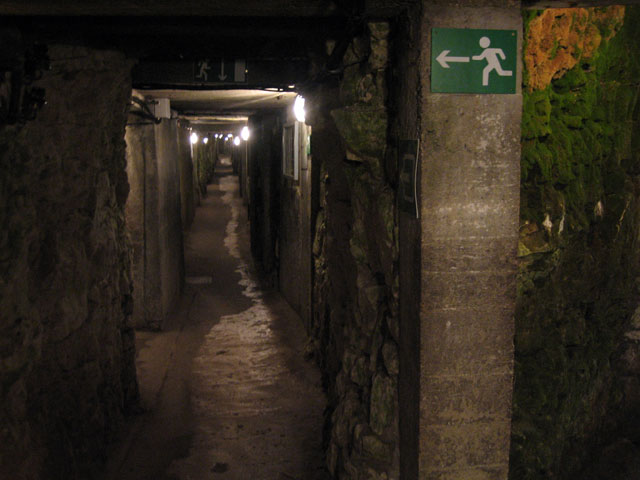
(Well preserved tunnel segment, the concrete pillars were added
after the war to make it more stable.)
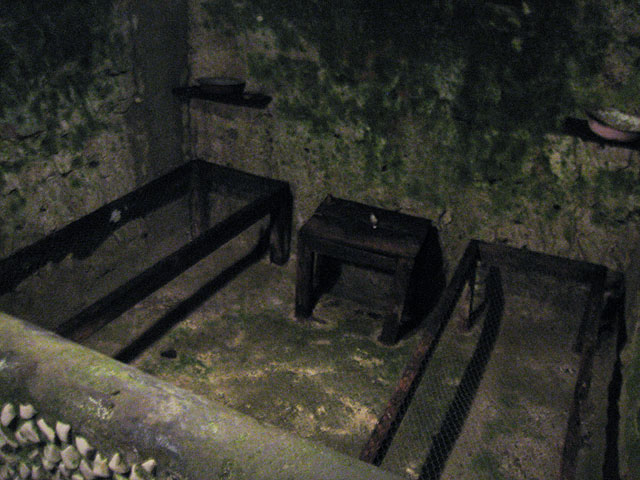
(Sleeping room.)

(Plan of the tunnel system)
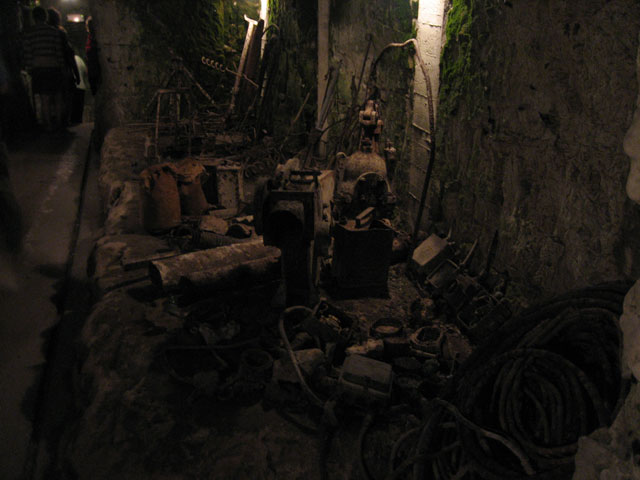
(Various equipment found in the tunnels.)

(Side tunnel.)
Unfortunately
my batteries inthe camera died down there, so I could take few
pictures and without flash only, so many pf them did not turn out
well. Pity. But it was quite interesting to see this tunnel system
and to compare it to the ones at Vauquois. Since
I took part in the last touor of the day, we were brought back up
after a rather short visit down there and the area was then sealed
off. So I got back on the road to Ypres. Since I was running late,
I left out my optional visit to the german cemetary at St.
Vaast. But at east I managed to do a short stop at the Yorkshire Trench in
Ypres, that I had to skip the day before.
Größere Kartenansicht I
intended to see this one on my first day, but did not get aroudn
anymore. The area was rather small and there was not much to see.
The recovered "Dugouts", the rooms that are under the
surface, are all full of water and so I was unable to see them.
All there was to see is a small reconstructed trenchsystem, much
like Bayerwald or Vimy Ridge. My camera was able to take very few
pictures, but needed a lot of time to recover between them due to
the battery being so low. 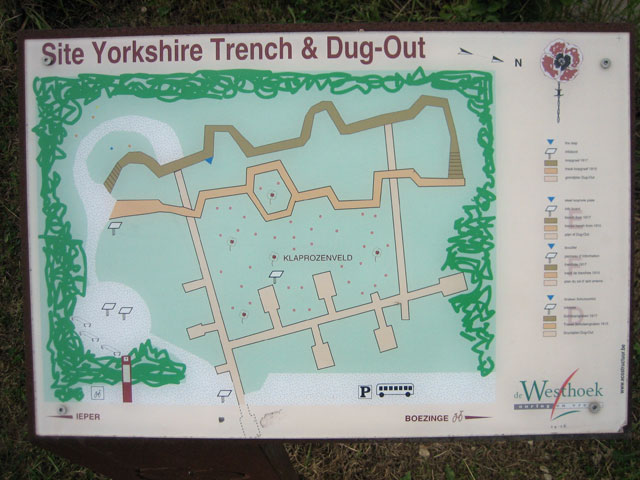
(Plan of the trench system.)
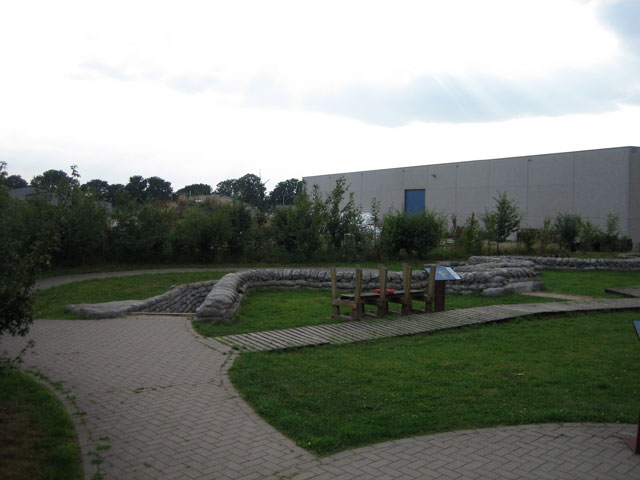
(Picture of the surface, in the middle reconstructed trench
walkboards.)
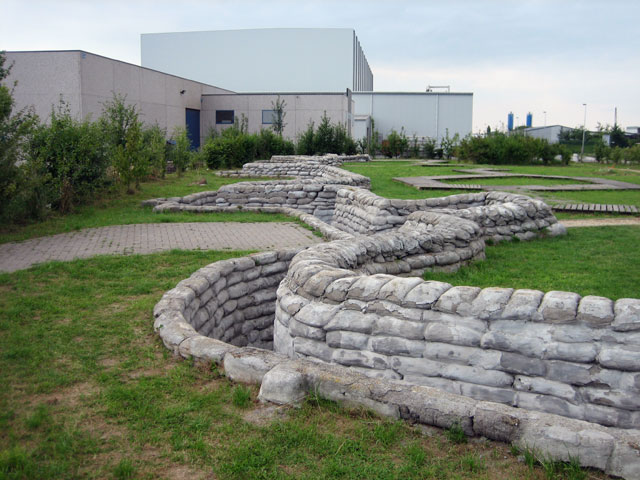
(The trenches from the side.)
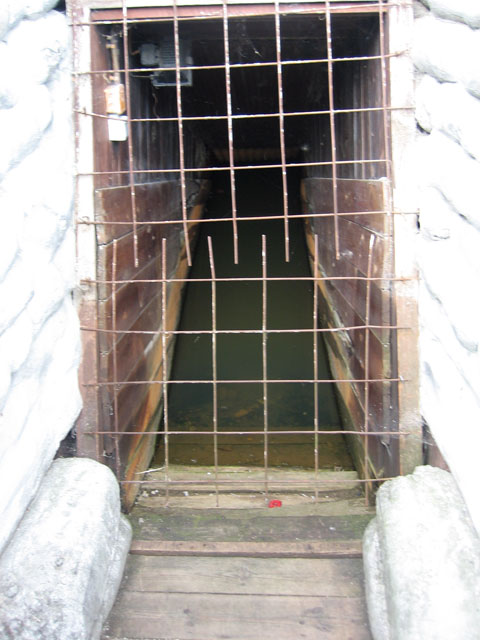
(Waterfilled entrance to the dugouts.)
It
was about time now to return to the camping ground since I started
to get hungry and I had seen most of what I planned for the day.
So I drove the short distance to the camping place and repeated my
BBQ from the day before with cold beer and everything. The british
family apparently got inspired by my BBQ and got themselves a
grill as well - and lots of meat. Unfortunately they were trying
to prepare about 2kg of meat on the same tiny disposable grill
that I was usiong and of which I know is only to good to prepare
2-3 pieces of meat and maybe some baguette. But thats
really all it can do - and they were just piling up meat on it...
When I was done with my steak, I went over and offered them to use
my grill as well (would have been good for one or two more pieces)
but they declined. Their fault. Some other british couple was more
interested in it and happily used it to heat their food up then. A
little contribution to " Völkerverständigung"... Pas-de-Calais
and the V-Weapon Bunkers Next
day, again a really densely packed program. The night was short,
but acceptable. Went to hit the bathrooms and took a longish
shower, which was much needed to warm up after the night.
Following that I had a small breakfast and cleaned out the tent,
packed the car and put the tent in last. Was still a bit moist,
which was not so great (yay moldy spots...), but there was no
chance to get it much drier with the grass still being wet from
the night. So off I went, picked up gas for the car and some
coffee for me and programmed my next target into the GPS unit:
Direction Pas-de-Calais. And shortly after 10Am I arrived at my
first planned stay for the day, La
Coupole, the dome.
Größere Kartenansicht this
is one of the giant bunkers dating from the second world war, that
was supposed to be used against London by firing V2 rockets from
it. The bunker was used as storage shelter for the rockets, start
platform and technology center, provided with a double train line.
It was never finished due to an attack with Tallboy bombs by
british bombers, that collapsed part of the building and made its
intended usage impossible. From the parking lot, it was impressive
to see the massive concrete cupola. Looks strange, very alien
actually. 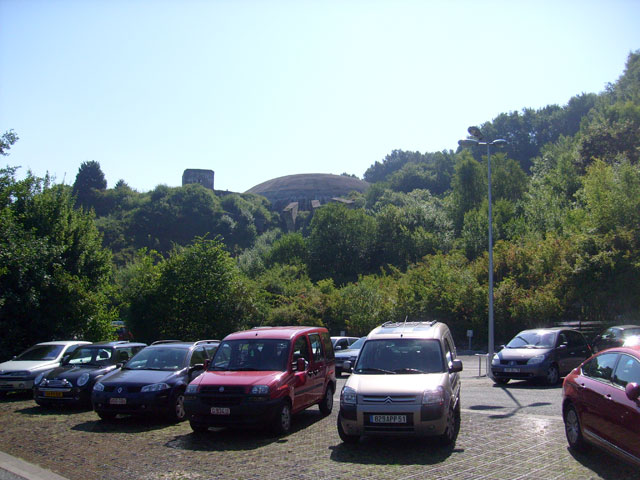
(The dome from the parking lot.)
I
passed through the visitos centre and bought my ticket. Heard
before, that there is an audio tour through the museum, which is
kind of wonky. Wenn I saw that the system uses infrared to
communicate, it was clear to me that this would not be perfect.
Radio would be impossible since there is too much reinforced
concrete in the bunker, but infrared does not sound great as well.
Anyways, I hooked up the system and donned the headphonews and
entered the bunker. 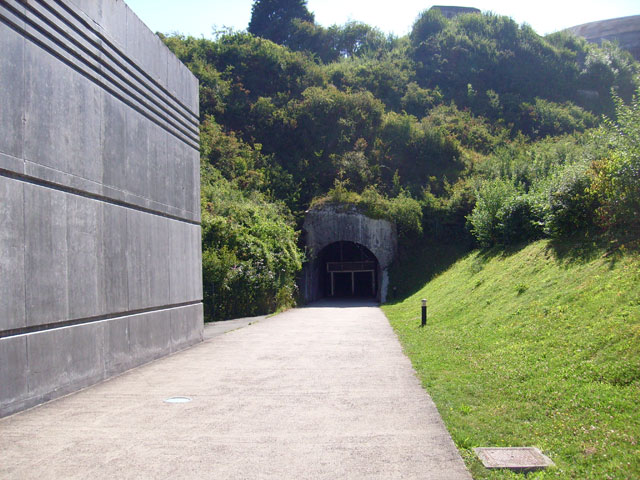
(Entrance to the bunker.)
First
I went into the area that was supposed to be used as storage and
for the machines necessary to run the bunker. Also the train
tracks would end here. There were some rocket parts and machinery
parts on display, which were quite impressive due to their size.
Actually the size of the whole bunker was baffling, a really
massive and large construction. Giant tunnels, broad walkways,
everything underground. It was unfortunatley all build under
terrible conditions by forced labor. 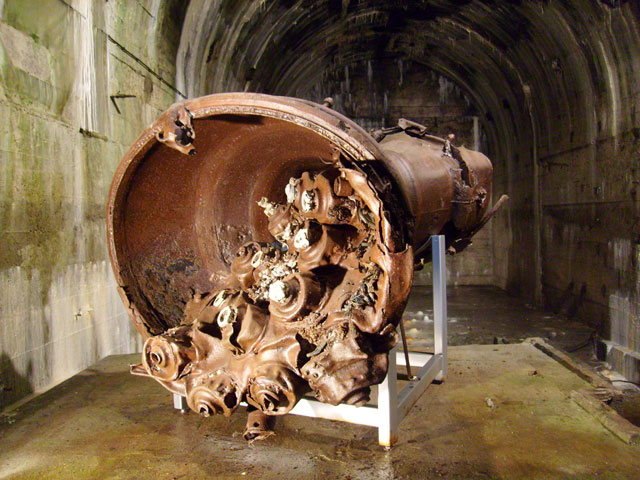
(Rocket engone opf the V2 rocket, half melted due to the enormous
heat following a fire in the bunker)
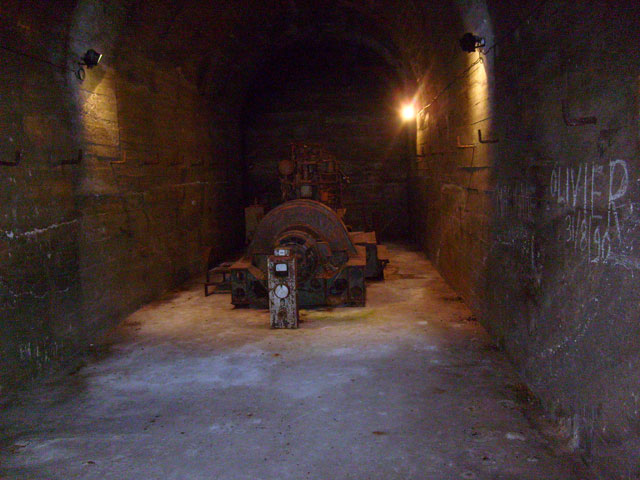
(Generator
in the engine room.)
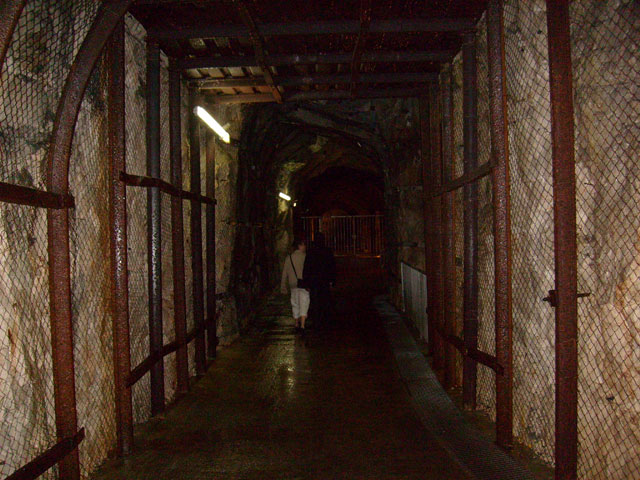
(Broad tunnels featuring the original reinforcements.)
I
went on to the museum area inside the bunker. My audio guide was
now working spotty at best. Unnerving. Inside the museum was a
really large exhibiton dealing with the bunker and its history -
but also a rather large exhibition about the Holocaust and Jews in
France. I noticed that the issue of collaboration of france police
and army was not mentioned at all, except for a footnote on one
small table. Kind of telling... You
could see a complete V1 rocket on display at the bunker, hanging
down on steel ropes from the ceiling. A surprisingly small machine
in comarison actually. Therei s also a V2 and a V2 rocket engine
on display, which were even harder to photograph due to their
size. The confined space in the bunker made it kind of hard to
take pictures anyways. But to see those two together is not an
everyday sight, so I took a bunch of pictures. The exhibition also
focused a bit on the history of spaceflight, which more or less
was founded on the V2 and its successors. It was not easy to get
all those different things in one exhibition, but it kind of
worked. But this way none of the focuses were really dealt with in
depth. In the end: An OK museum but not great. 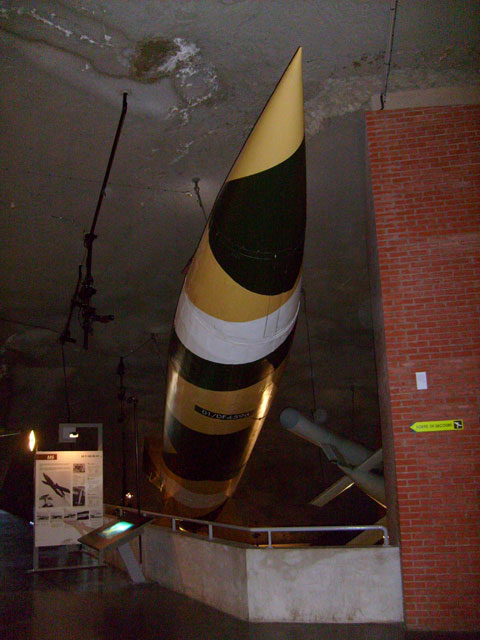
(V2 viewed from the front.)
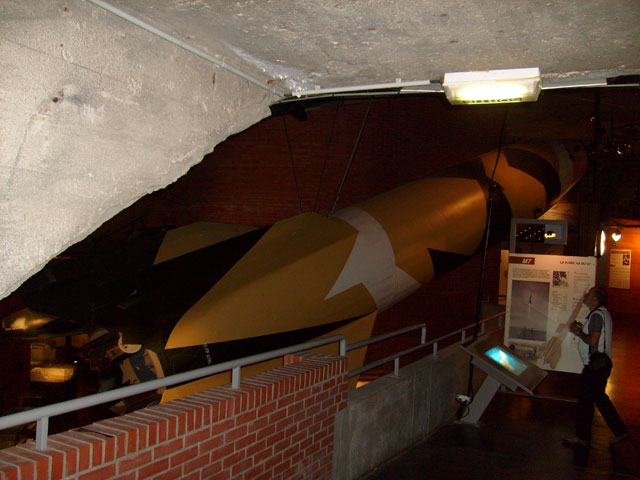
(V2 - complete, from behind.)
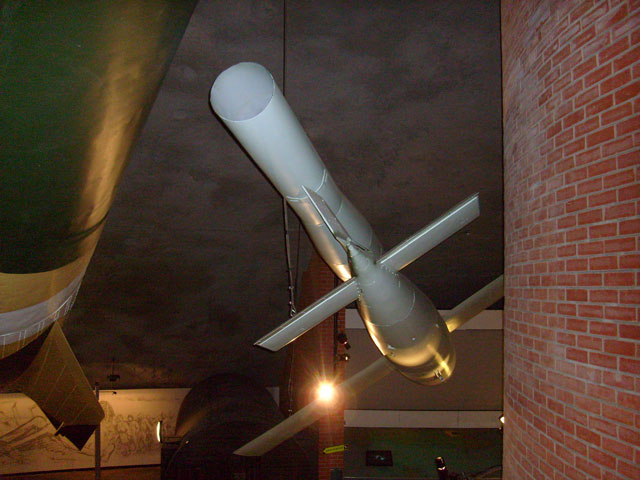
(A V1 from behind.)
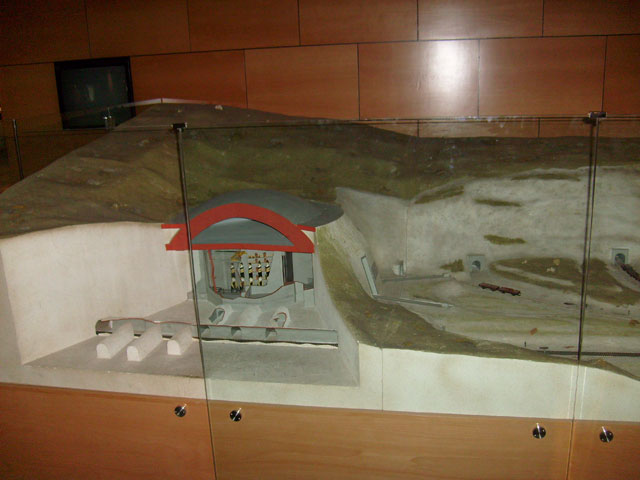
(A nice model of the bunker and the dome how it was supposed to
look line in the end.)
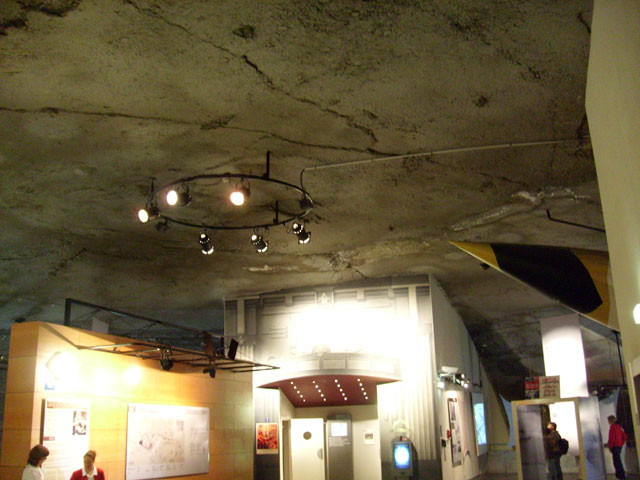
(Concrete dome cupola - notice the thick cracks in the concrete as
a result of he bombing with Tallboy bombs.)
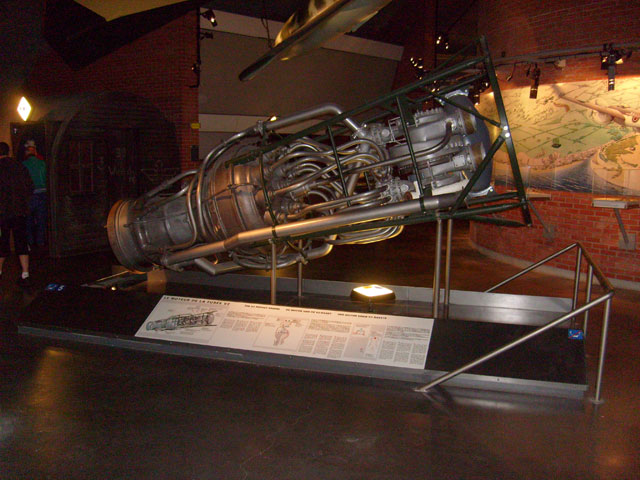
(engine of a V2 rocket - goos as new.)
By
this time my audio guide was completely dead, so i just shouldered
it and read the info tables instead in cases I had not too much of
an idea of what I was looking at. The infrared system has a
problem in the museum anyways: If you move slilghtly out of the
way in front of an object, the system interprets this as a move to
the next exhibition item and so the audo comment changes abruptly.
And it likes to change back to the old one then as well - of
course at the beginning.... 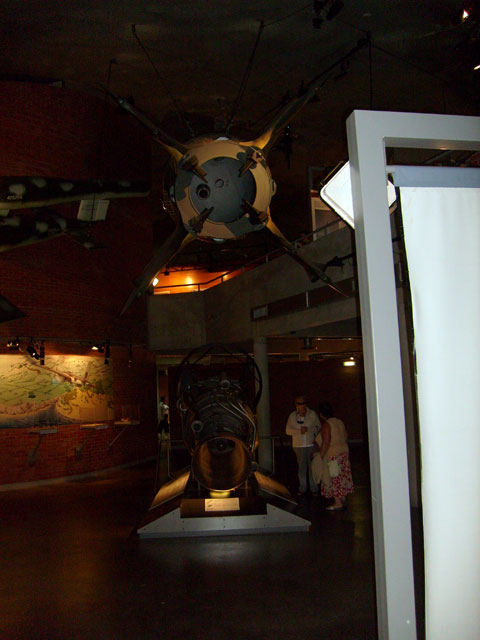
(Motor and V2 from the lower level and behind.)
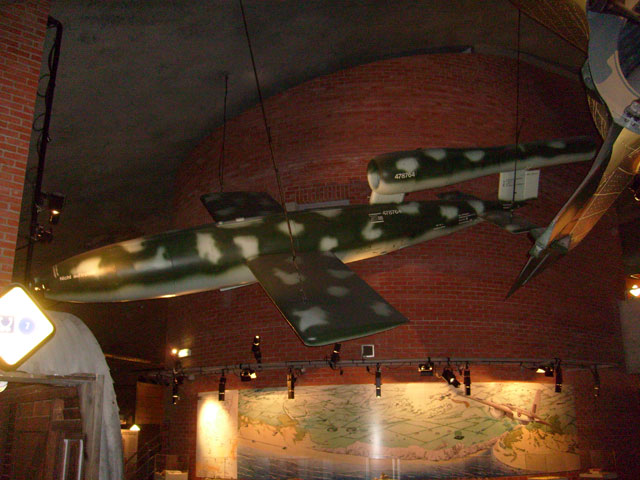
(A
V1 dangling down from the ceiling, best shot possible due to the
confined space.)
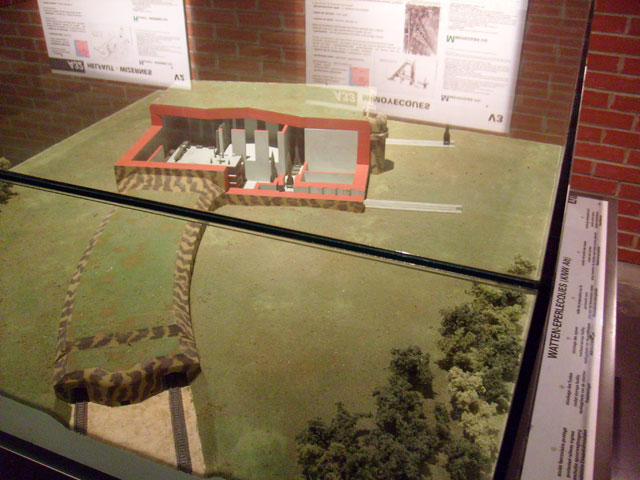
(A model of Eperlecques, the other V2 Bunker I was about to visit
that day. Helpful to get an idea of what I was about to see!)
After
the exhibition the tour went into the never completed launch
preparation chamber for the V2. The plans wanted to create a giant
room in which the rockets would be transferred from horizontal to
the vertocal position, then get fueled up and driven on a start
ramp out of the building to be launched. A platform outside the
bunker and the hill would be the place, where the rocket would
have been launched from. Two start platforms were planned,
resulting in the bunker being able to fire rockets towards London
within minutes of each other. 
(Tunnel to the main room under the dome.)

(View towards the ceiling. The limestone block is visible, which
was about to be blasted to pieces, resulting in the doem room to
be complete. Wouldn'thave taken much longer to finish the site...)

(Explaining table for this room.)
The
size of the room is less impressive due to the limestone still in
its place. However looking towards the ceiling reveals an
incredible height and one realizes, just how massive this
installation was going to be. 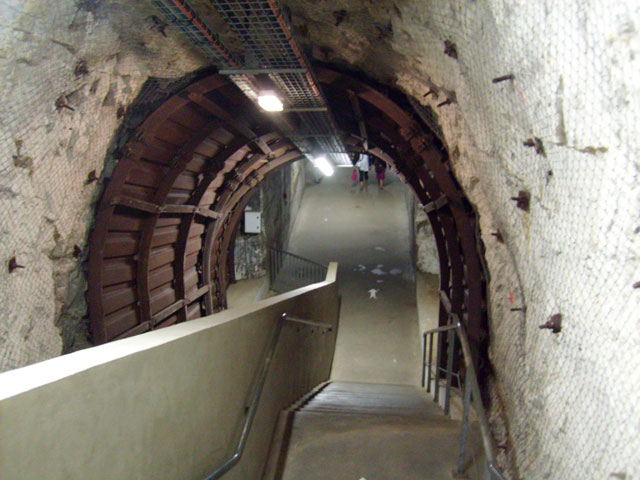
(Towards the exit from the bunker.)
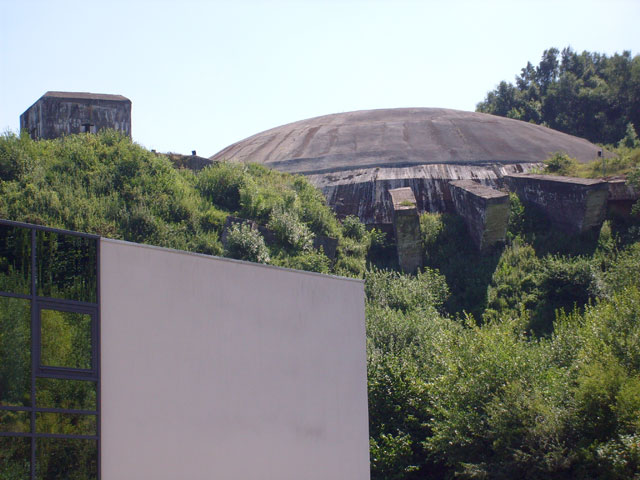
(A last view to the dome.)
After
my visit I stopped for a while on the parking lot to have a little
snack and then went my way to the next stop for the day, the V2 Bunker in
Eperlecques. This Bunker, also known as the "Blockhaus",
was planned just as massively as La Coupole. Like here V2 Rockets
were supposed to be launched from platforms, a huge interior space
was built for storing and directing the rockets and also plenty of
space was planned to store and maintain warheads, propellant and
service technicians. Contrary to La Coupole this was not going to
be built in a large hill, it was planned as a classic "Hochbunker"
right in the middle of a small forest. An incredible effort was
done here to build such a huge construction and to fortify it
against aerial attacks. However the massive Tallboybombs managed
to destroy sufficiently large parts of the bunke so the original
plan as a V2 launch site were scrapped and instead a liquid oxygen
plant was installed that provided mobile V2 ramps with fuel.
Größere Kartenansicht About
45 minutes later I arrived at the Blockhaus. Had another little
snack since it was around lunchtime and the sun had climbed
substantially. Besides it doesn't hurt to have something
substantial in your stomach... 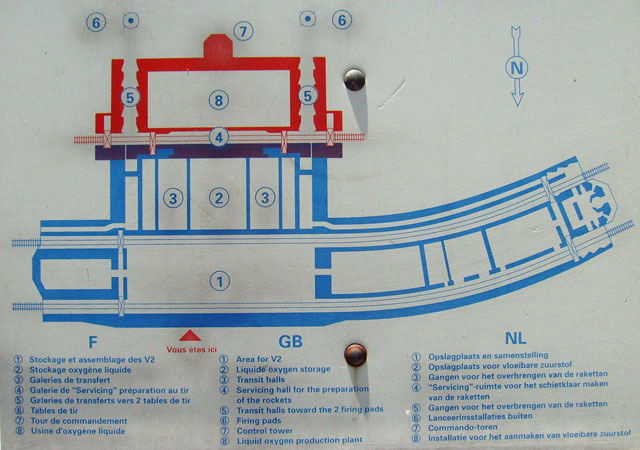
(Plan of the bunker)
Passing
the entrance buuilding, there was nice pathway to the bunker, that
suddenly peaked through the forest. The way to it was dotted with
military equipment of which some was actually relevant to the
bunker. But aso the not-so-relevant ones were rather interesting
to see. 
(Mini-U-Boat for 2 Torpedoes.)
I
managed to get to the bunker within a few minutes, passing a tiny
one-man bunker and more war meterial. Turning around at a curve, I
suddenly saw the massive bunker right ahead of me. A rather
overwhelming, massive construction with its straight lines and
monumental size. Just massive! I felt pretty dwarfed next to this
huge box-like concrete structure. 
(First impression of the bunker.)
Originally
the launch pads were supposed to be located at the sides of the
bunker, however due to the aerial attacks this was never finished
and a slanted concrete slab was instead poured to seal of this
entrance. 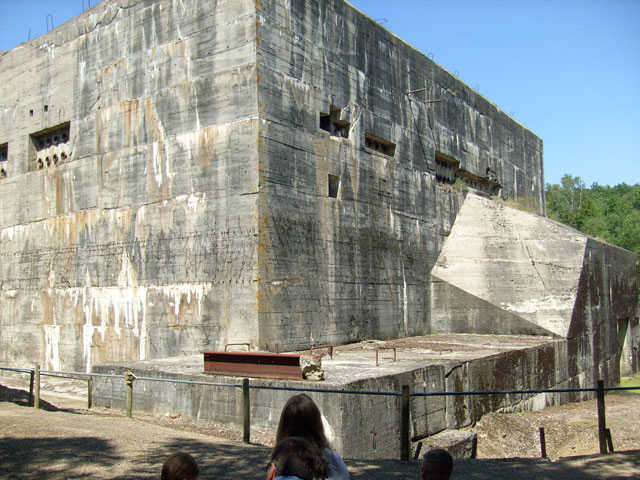
(Closed launchpad.)
During
this attack it proved necessary to abandon the plans of using this
Bunker as a V2 launch site, and rather use it as aliquid oxygen
facility. Reason is that due to the technology back then, the
liquid oxygen evaporated quickly,, so it had to be produced not
too far away from the mobile launchers used. The daily production
of oxygen was only sufficient to launch 20 rockets at most - still
a scary thought. 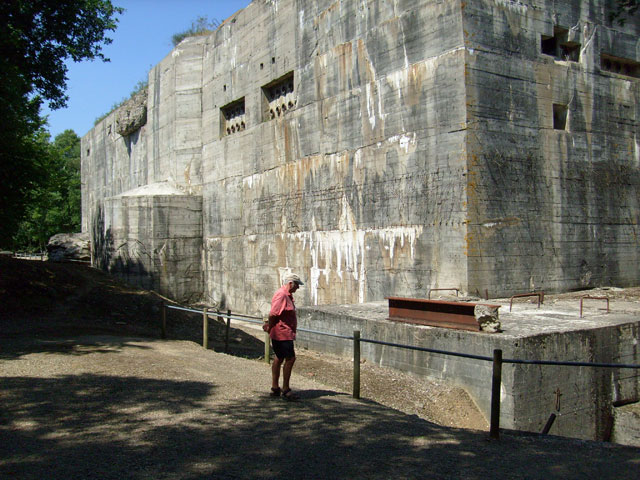
(Using a tourist for measurement you can see the massive size of
the bunker.)

(View through the bunker from the side, at the end you can see how
tiny people are.)
The
Bunker sank a few meters into the ground since the war due to its
weight and is partially under 2.5m of water, To be able to visit
it though, part of the bunker got its ground level raised by 3m.
Makes the rooms look a lot smaller unfortunately. I
continued my walk to the northern part of the bunker. This part
was completely devastated by the aerial attack and was not
rebuilt. The southern part did not break due to its massive 5m (!)
thich roof that was just before the attack finished. To construct
this slab and to work in some safety, the eroof had been poured,
dried and then riased using hydraulic jacks, then a meter or so of
the sides was poured, dried and the same pattern repeated until
the bunker reached its final height. An incredible amount of work
was done this way! 
(Northern part of the bunker and its destruction.)
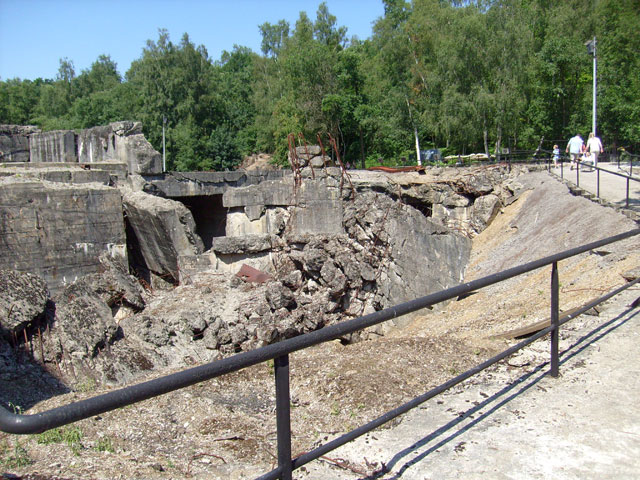
(Complete mess of steel, concrete and cement.)

(Looking along the outer wall of the bunker.)
I
walked a bit further and sat donw on some of the benches there to
see where the trains would have arrived with the rockets and to
see the depots for them. In the backgournd there was an audio
guide being played via loudspears in severaly languages, so
you could listen about the history of the bunker. Quite
nicely done and fitting to the bunker. 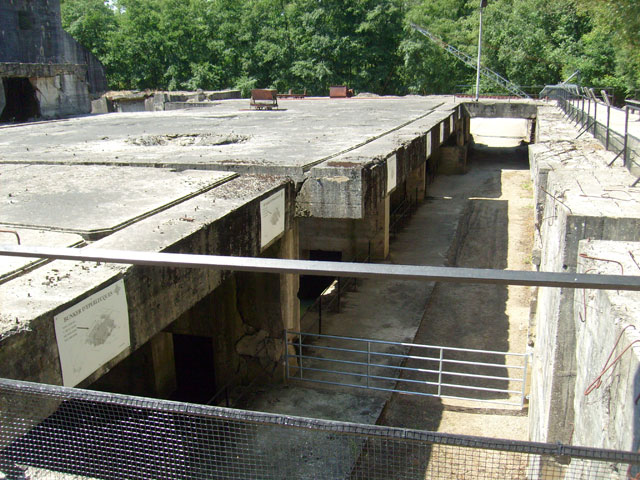
(Arrival train station for the rockets.)
A
small train was used to get the material to the bunker site.
During the bombing attack, a lot of the forced laborers were
killed, the material that got thrown off the train during the
attack was left lying around. The bags of cement soaked up water
and solidified everywhere. A strange sight to see. 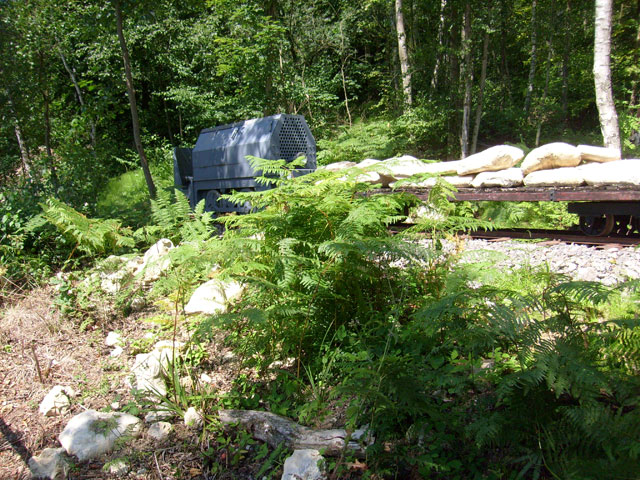
(Cement bags in the foreground, train in the back.)
Contrary
to most other forced labor worksites, this construction zone was
using a lot of modern equipment including cranes in order to be
able to finish the bunker in record time. That did not work out,
but considering the circumstances the completed 30% are pretty
imperssive. It was also then used as the LOX manufacturing site,
so it got used indeed in the end. 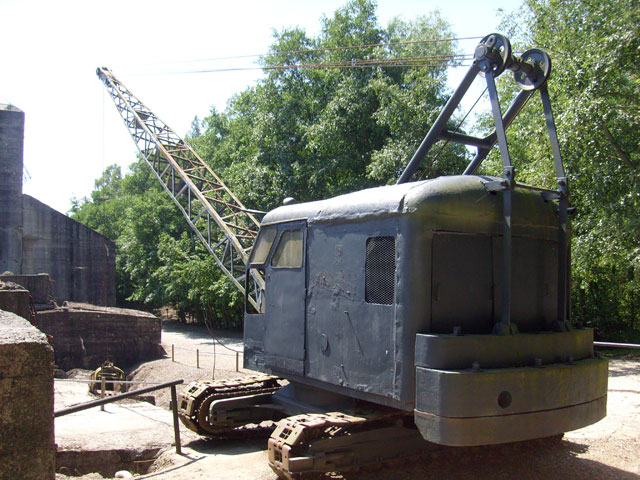
(A crane used during the bunkers construction.)
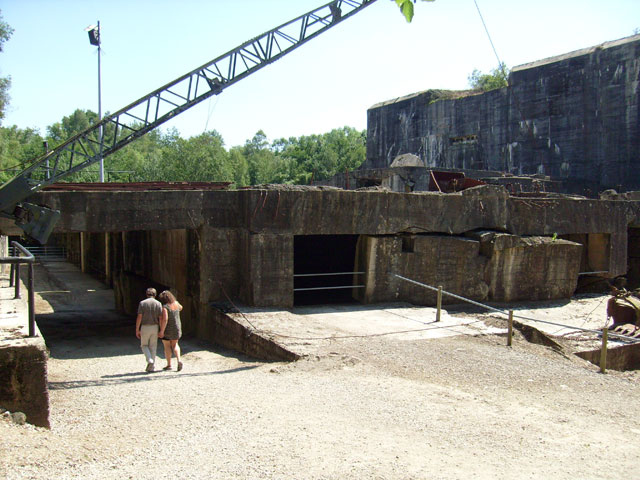
(Access to the train station for the rocket delivery.)
Entering
the area where the trains were supposed to arrive, the massive
devastation was quite apparent. The bunker had to be left as it
was, fixing it would have been to complicated and costly, removing
the debris was also way too timeconsuming. 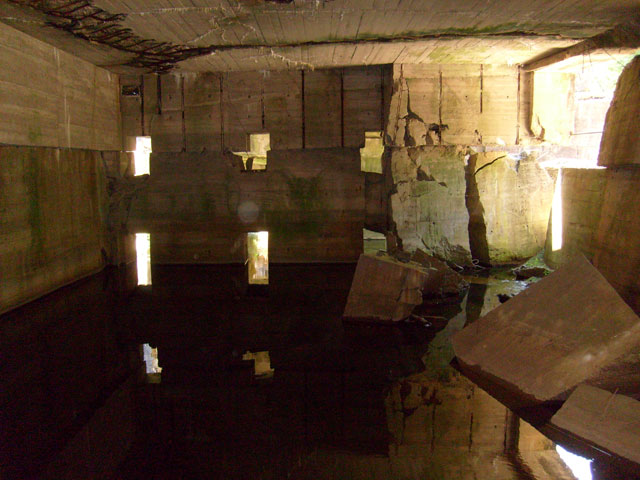
(Destruction in the depot of the bunker.)
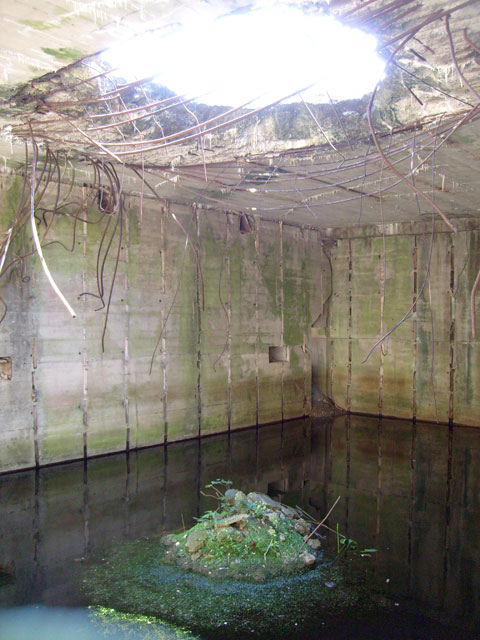
(Bunker deep under water and hole in the ceiling where a bomb went
through.)
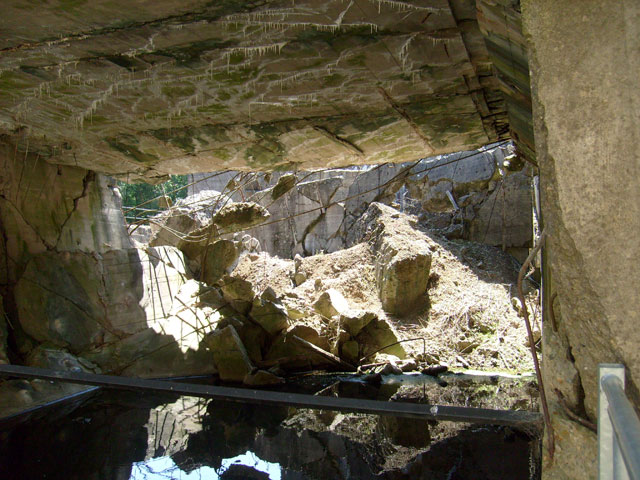
(Complete destruction on the left side.)
After
I saw the destroyd northern section of the bunker, I went along to
the southern part that is still mostly intact. Besides being used
as the LOX site, there were plans to try to get one of the ramps
to be used as a launch platform again prvided they would have been
able to clear the area of most of the debris. Due to the continued
attacks on the bunker, this was never done though and work stopped
on the bunker. 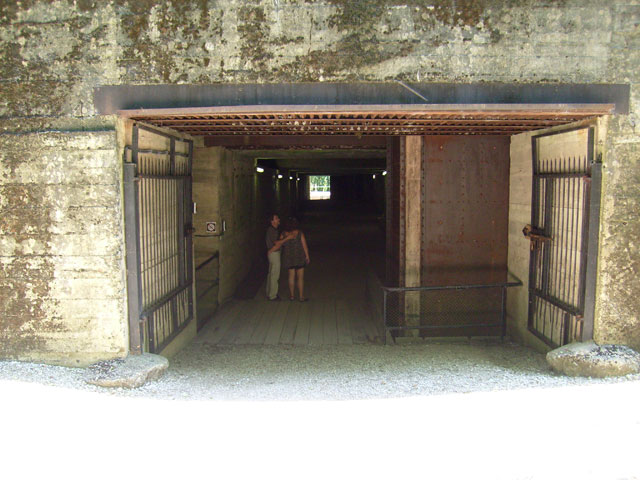
(Gigantic steel door to the bunker.)
Inside
you could see what a massive size this bunker has. The digicam had
problems to get the ceiling on the pictures because it was so dark
and the flash was not reaching far enough. Keep in mind that the
ground here is 3m above the original ground, so it was even bigger
before! Next to the door a launch pad was shown to illustrate how
the corridor to the launch pad would have been used. The biig
corridor in the middle was supposed to be used to get the rockets
from horizontal to vertical firing position. And the massive room
in the middle was used then for the liquid oxygen production. 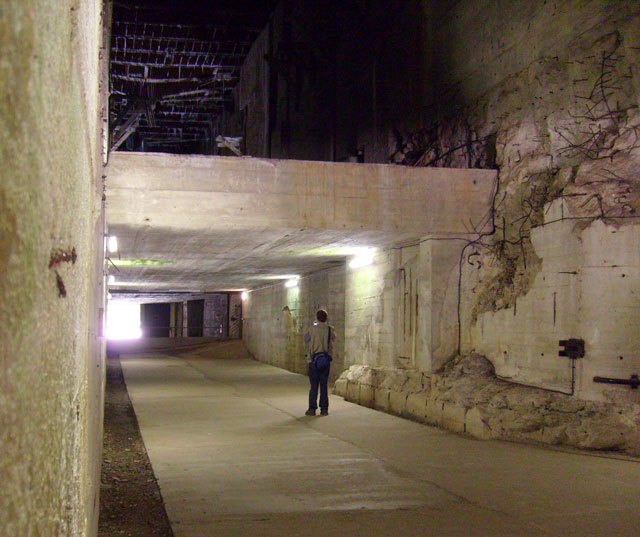
(Remodeled corridor with a concrete floor in the middle. At the
ceiling traces of an exploded Tallboy bomb that did not manage to
fully penetrate the bunker. Still managed to cause massive
destruction inside.)
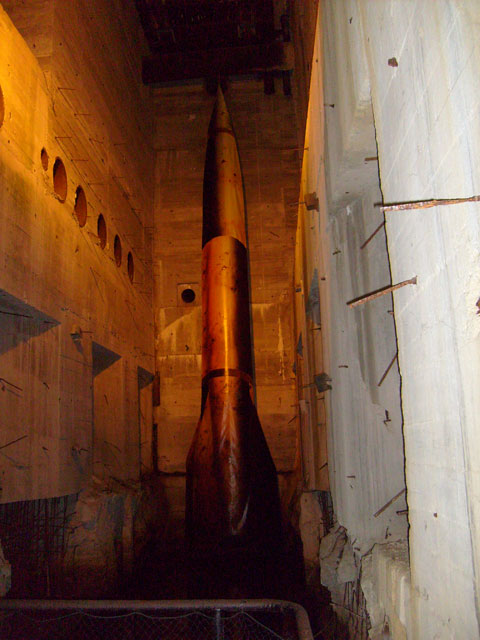
(Modell of a vV2 in the start corridor leading to the intended
launch pad. The little caves in the walls were supposed to help
against shock waves..)
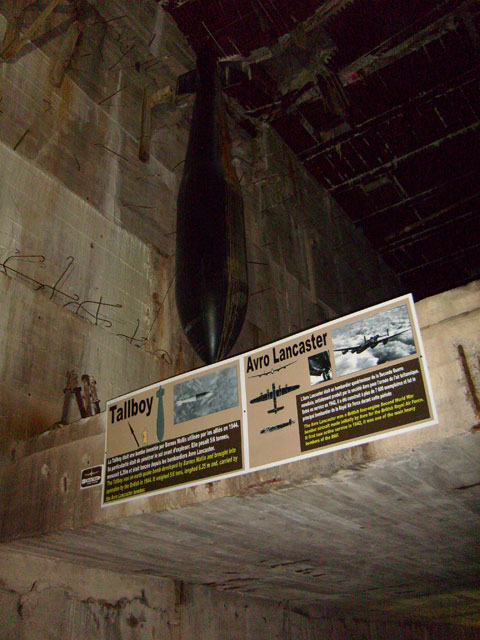
(Model of a Tallboy bomb.)
the
main room was rather empty, only parts of the machinery are left
here. YOu could see a presentation about the bunker, but the movie
took pretty long and I arrived at the wrong time for a language I
speak. So I only took some pictures and left again. 
(machinery for liquid oxygen production)

(Lower level of the bunker, ful of water.)
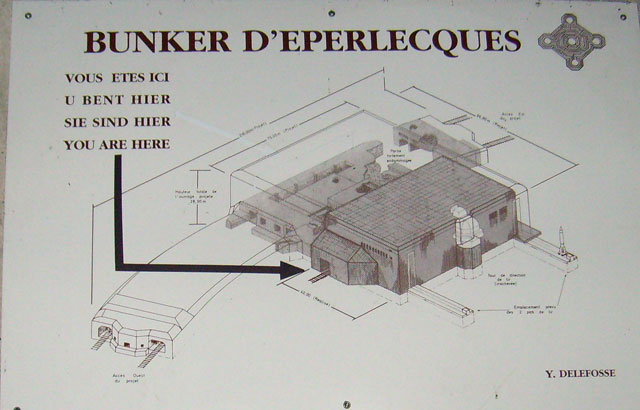
(Plan of the finished bunker at the exit.)
I
left then the big bunker and looked at the rest of the facility.
One of the last V1 mobile ramps is on display here! So I went
there and looked also at the big pretty lake they had there -
turns out it is the crater of a tallboy bomb, measuring 25m
across... 
(Bunker from the front, in the middle the inteneded launch control
tower.)
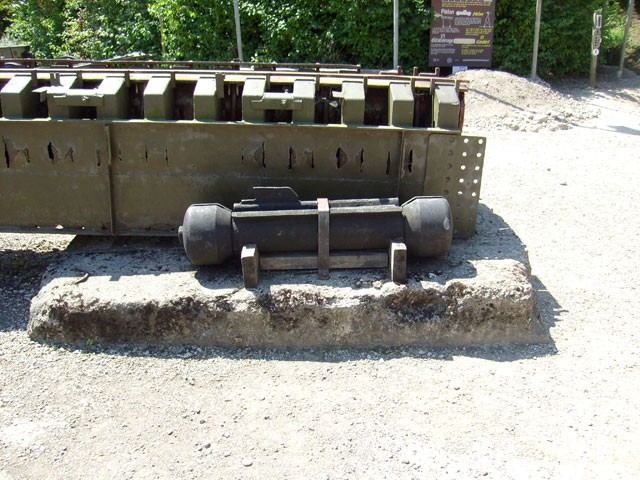
(Catapult device for launching the V1 rocket. It was propelled
with steam toget the rocket to a speed where its engine would
start.)
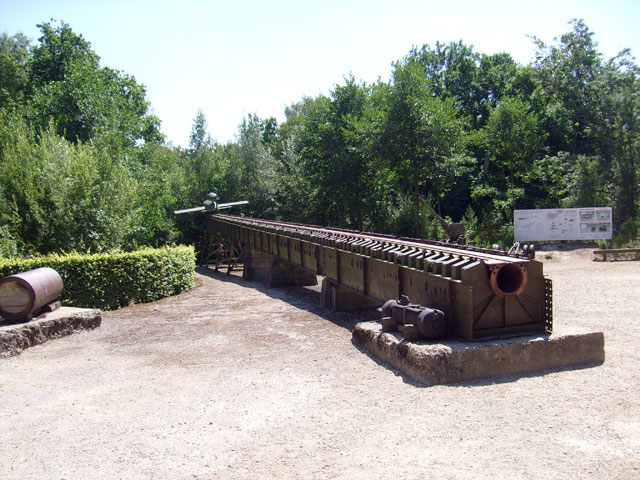
(Closeup of the ramp.)
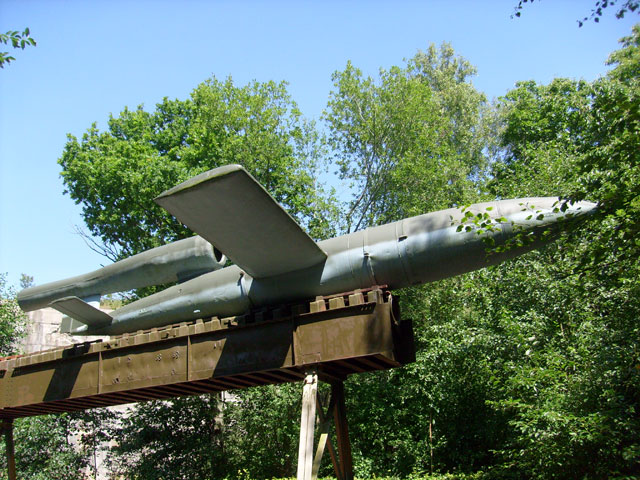
(V1 on its ramp.)
I really
took a lot of pictures here and stayed for quite a while to let
the impression last on me. Then went on to the exit of the site
since two more things were on my list for the day, the V3 at Mimoyecques
and the Battery Todt directly at the channel coast. On
the way to the "fleißige Lieschen" I stopped at a
french store to pick up some local specialities for Tia, french Quiche
Lorraine and one, two local things. Unfortunately this region is
known for its soft cheeses which Tia is not a huge fan of... And
due to the problem with the powerbox in my car I couldnt store so
many things anyways and keep them cold. I could buy a bag of ice,
that made things a bit easier though for a few hours. A
bit more driving alter I arrived at the V3 tunnel. Thanks to the
shopping in between, it took me more then an hour to get here, not
so great for my plans... After the really impressive V2 bunker,
the V3 bunker was a bit of a letdown, since it is way more simple
and much less is left of it. This site was never finished, alos
bombed with Tallboy bombs the site was partially destroyed and
blwon up after the war by pioneers. Besides: The V3 canon was
never finsihed anyways, two smaller versions of it were used on
mobile ramps against Luxembourg and Belgium at the end of the war
with very little effect.
Größere Kartenansicht I
arrived at the V3 site, bought my ticket - and was addresses in
german, which the owner spoke. Nice, but I was really trying to
improve my french during the tour, but alas... I went into the
hill using the main tunnel. 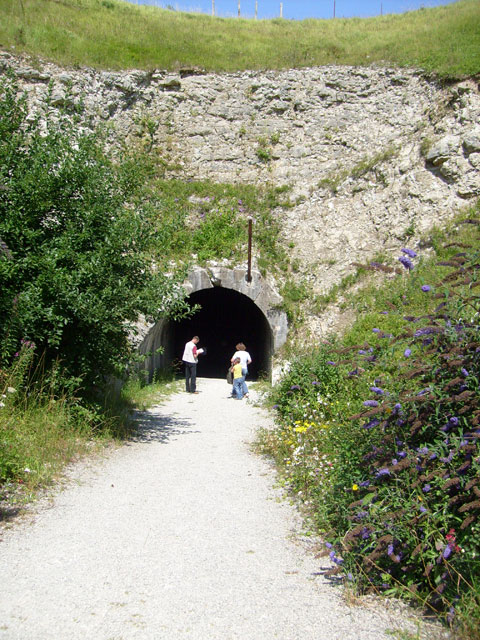
(Entrance to the tunnel.)
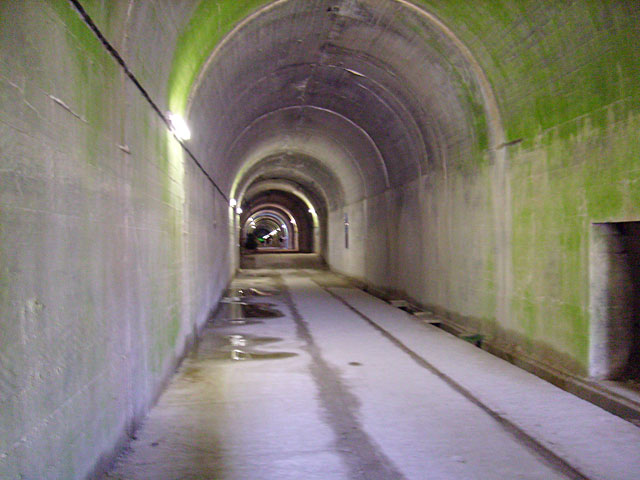
(Without a tripd taking pictures without flash is difficult - the
camera is not that great for this use.)
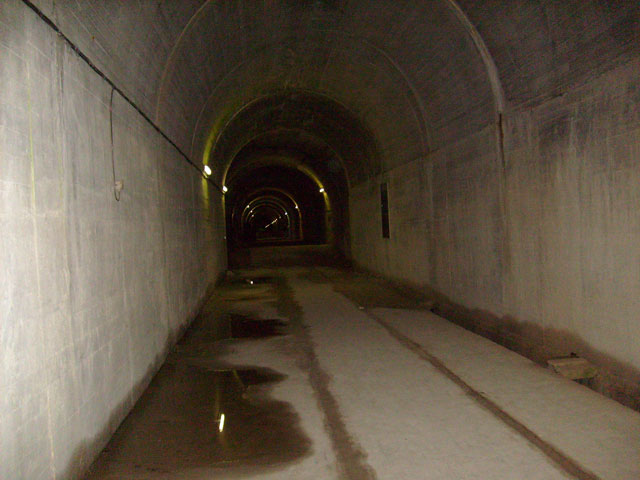
(With flash the tunnel disappears into darkness...)
I
started the roundtrip through the tunnels using the sparsely
documentation provided there. The inside is almost completely
devoid of tables or signs and even if there are some, they are
illegible by water and mold. Pity. The light inside the tunnels
though was nicely done, a mix of cold hard light, darkness and
colored ligths at the memorial sites. Atmospheric. 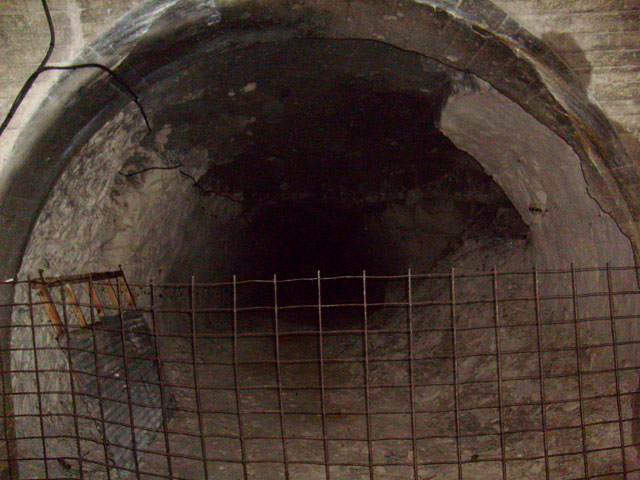
(Caved in tunnel to the side.)
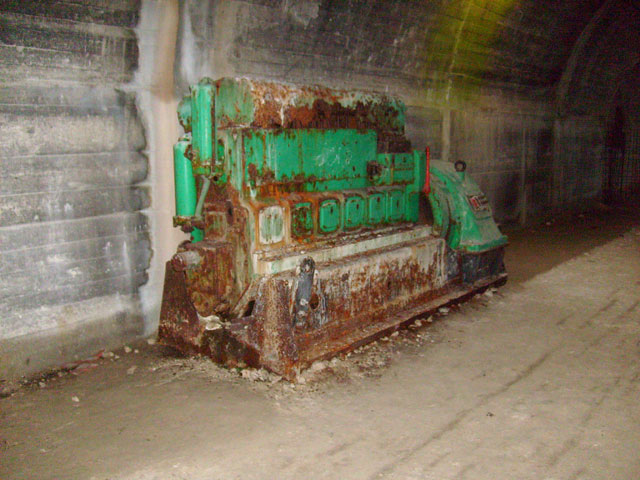
(Generator for electrictiy in the tunnels.)
It
was very wet inside the tunnel system, the lens of my camera got
moist a lot and I was happy to be wearing a rain jacket and warm
clothing. Other tourists were less well clothed and visibly cold.
The bunker site consists of a lot of smaller tunnels that
interconnect at bigger tunnels. A few chambers were created to
accomodate enigne rooms and such and there were shafts going to
the surface to be used for the cannons. Everything else was stored
in the tunnels themselves. 
(Tunnel.)

(Memorial for the forced laborers killed during the aerial attack.)
After
a relatively short time I arrived at the main part of the tunnel,
the V3 launch site. Five of these shafts were to be dug in the
gournd, each contaiing several launch tubes, pointing towards
London. The idea was to use them to constantly bombard London with
it. One of the few reimaining V3 parts has been installed here to
show how it would havel looked like if the V3 was ever finished.
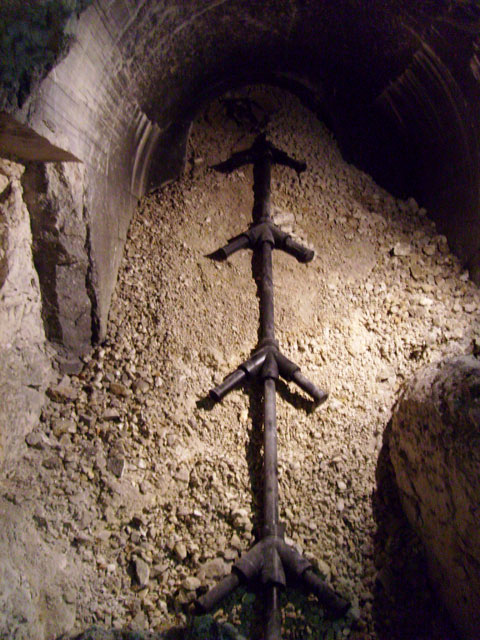
(Taken without flash at the well-lit part.)
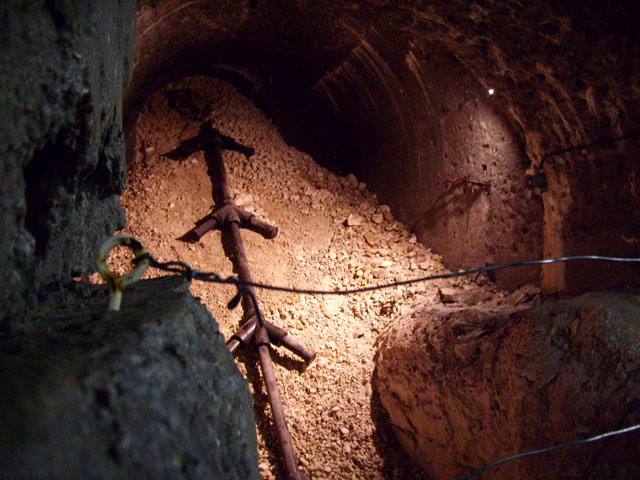
(Another one, long time exposure. At the top you can see the
collapsed shaft.)
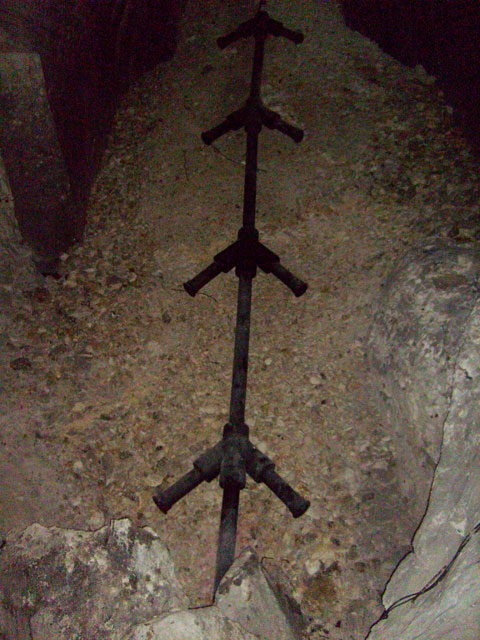
(The V3 using flash.)
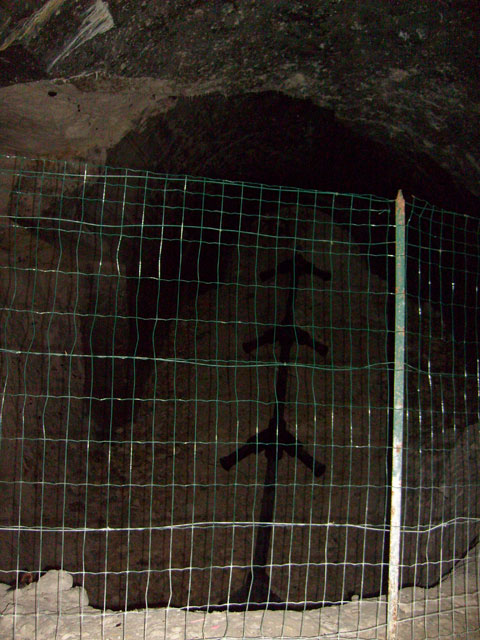
(And a bit further away - the fnece made taking pictures pretty
terrible.)
Back towards the
entrance, to see more of the rooms where the eninges used to be.
Unfortunately they are rather empty. The whole site was blown up
after the war and most of its installation was removed beforehand.
Since it was never finished to begin with, it certainly was the
lessest impressive and well.kept V-Weapon site I visited that
day. 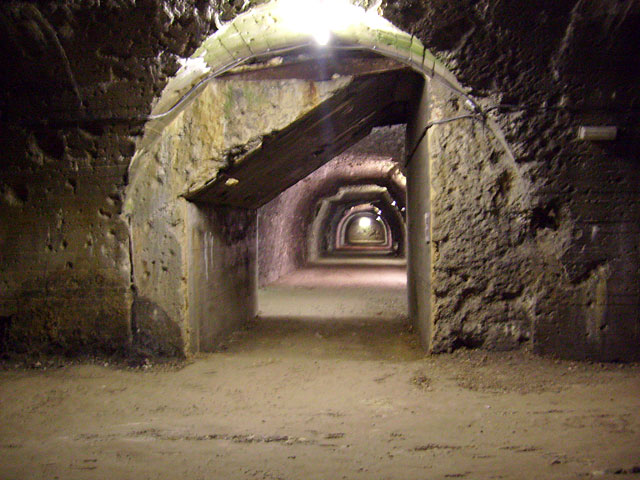
(Part of the tunnel with concrete walls.)

(The tunnel with the V3 in the background.)
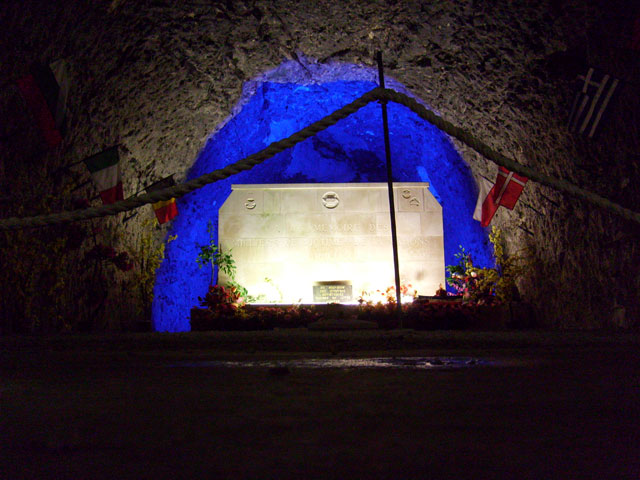
(Monument)
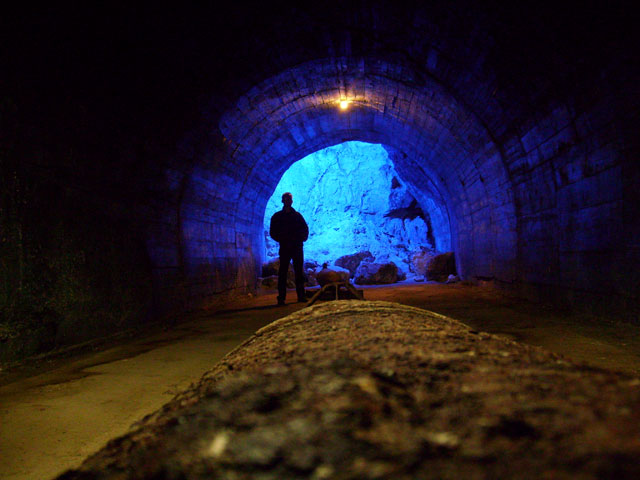
(Caved in tunnel.)
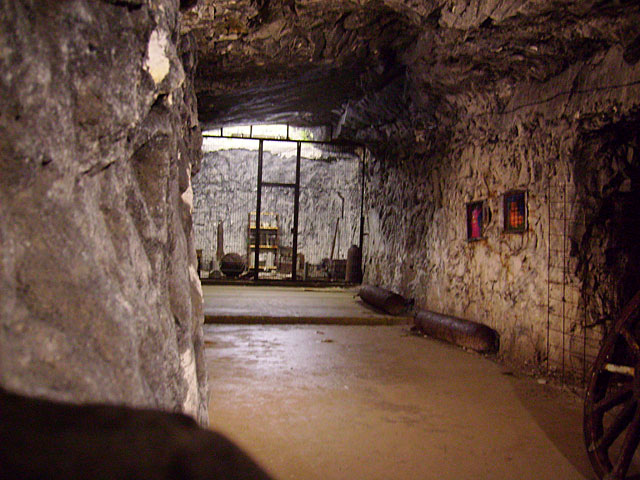
(Machine room.)
The machine
room featured a tiny exhibition and among the items was a
Röchling projectile. Those were supposed to be used in the V3,
but never worked that well. Some other more or less interesting
things were on display as well. Alos pretty cool were the
machinery marks on the wals from the jackhammers et. But since
there was not so much to see, I packed up my camera and made my
way to the exit then. 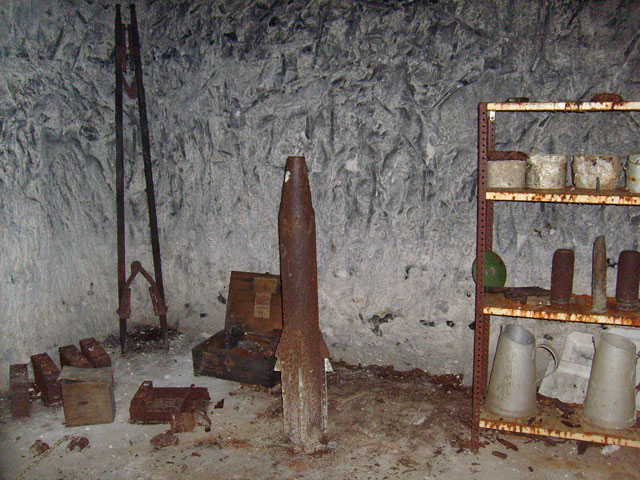
(Röchling arrow projectile for the V3.)
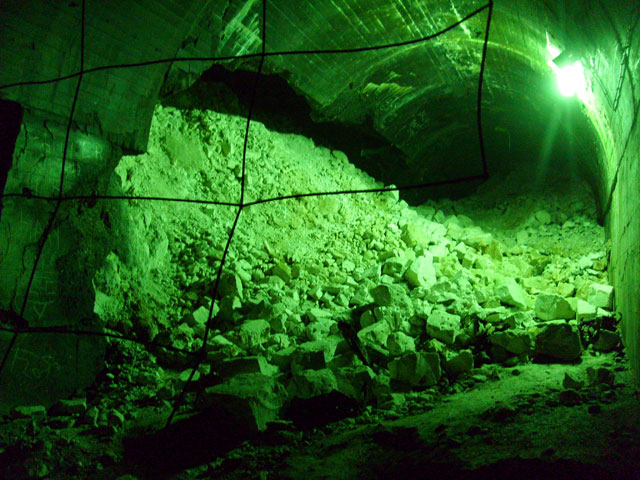
(End of the main tunel, the rest of the 150m or so are caved in by
an explosion. The green light nicely accentuates the tunnel, liked
this very much!)
A short
march later; i got back to the exit, packed my stuff in the car
and changed the camers batteries. It would have been nice to see
the surface of the site, but at that time I had no idea that tthis
was allwoed so I didn't do that. Pity! My
last target for the tour was now the Battery
Todt, one of the biggest artiellery installations of the
atlantic wall at the channel coast that duelled occasionnally with
the british guns at 40km distance. More or less the only ground
attack germany did on England during the war, excluding the
channel islands. Lucikly the invasion of England never happened
and the outcome of the areial battel of Britain was also not in
favor of the Nazis...
Größere
Kartenansicht
My ride to the Battery was met with
the usual problems: Every second street is named "Rue
de", what makes using the GPS unit a nightmare - also road
siogns are not that clearly labelled and less then helpful
occasionally. Plus: During my preparations I wrote down the wrong
adress for the battery, causing me to go to Kap Gris Nez
instead of the Battery at first. The cape offered a nice view on
the foggy channel (Dover was hidden in the fog) and a few bunkers
which were recently bricked up and covered with earth (bummer!).
But looking around I quickly dicovered the towers of the Battery
and went there using eyesight only :)
In general the site has been turned
into a "museum", howver its one of the worst kinds.
Though some spectacular things are on display, the sheer mass of
militaria on display without a concept behind it, let it appear as
more of a military surplus store and less of a historic site.
Something I did and will always encounter on those trips I'm
afraid. Some of the stuff in display inside the bunker was alos of
quite iffy origin - and traing to sell Nazi memorabilia never sits
well with me. Alas.

(Batterie Todt to the left a not so well kept Panzer.)
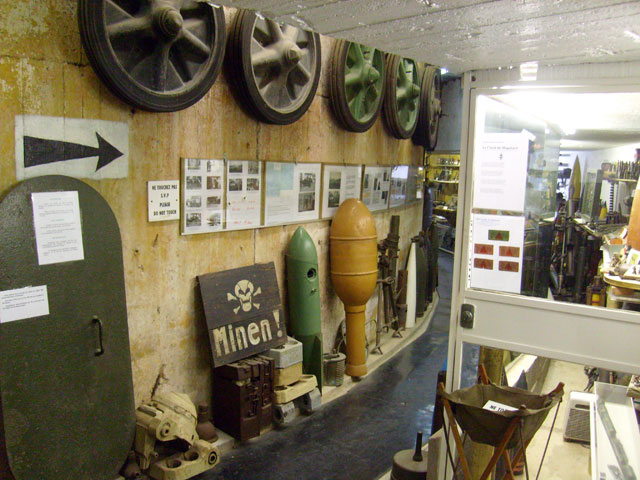
(Inside the museum, lots ofmilitary equipment but among the mass
if stuff are some rare gems.)
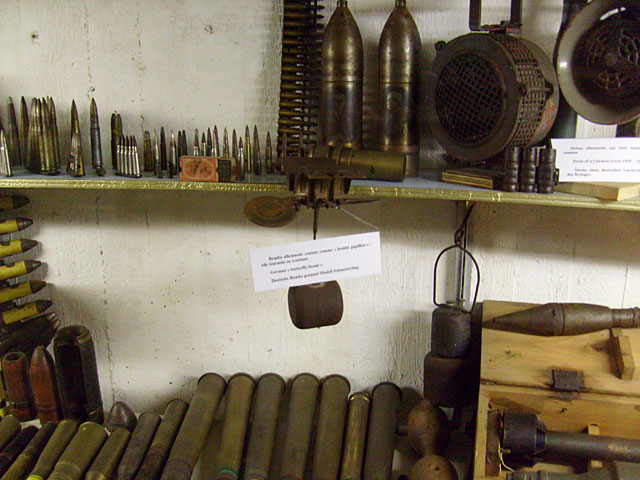
(Like this: A german butterfly mine.)
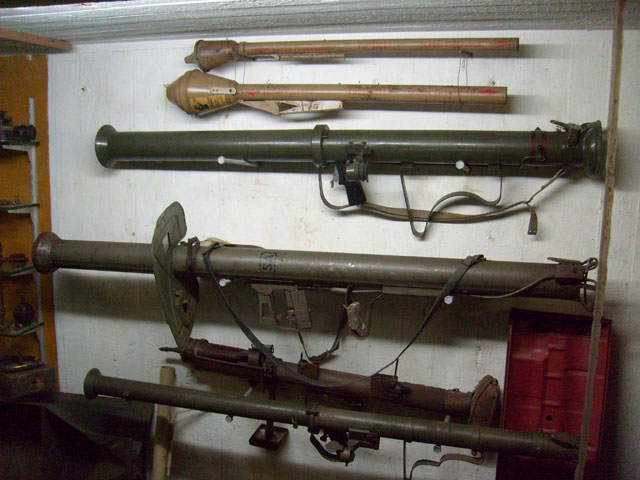
(Bazookas, Panzerschreck and Panzerfäuste. Also a british PIAT.
But no explanations, context or anything.)
Inside the tower was even more war
material - but any information about what was on display besides
the most basic stuff is sorely lacking. Also: Why is on display,
but... whatever. That there was a huge gun in here before and what
it did: Complete mystery.
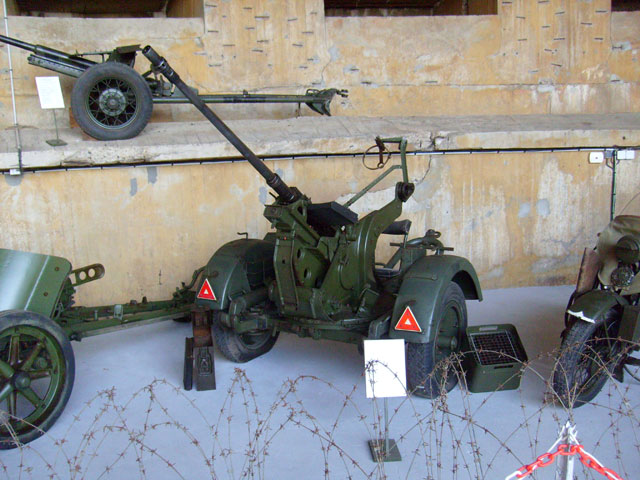
(Exhibition in the tower.)
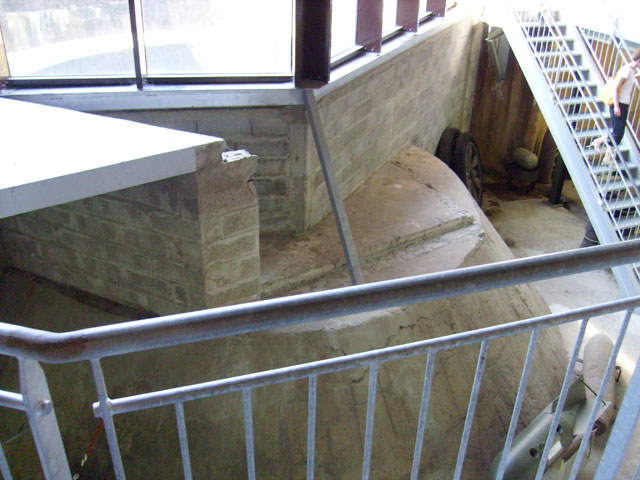
(Gun turret foundations.)
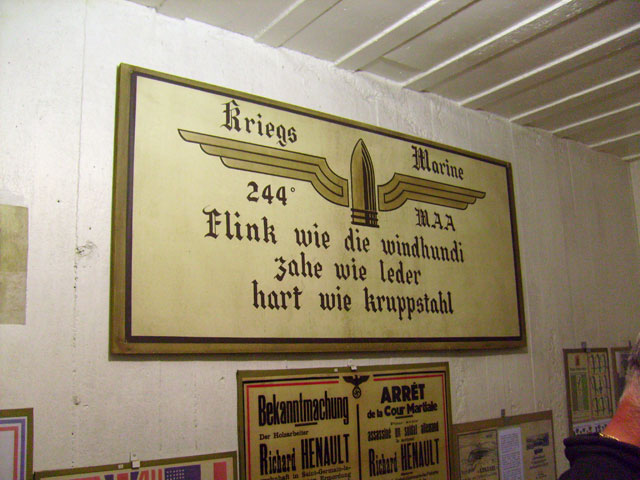
(Questionable Militaria at the "Museum".)
I walked on and saw the lower
levels of the tower where the storage and living quarters used to
be. The rooms were for the most part crammed with military stuff
and surplus.
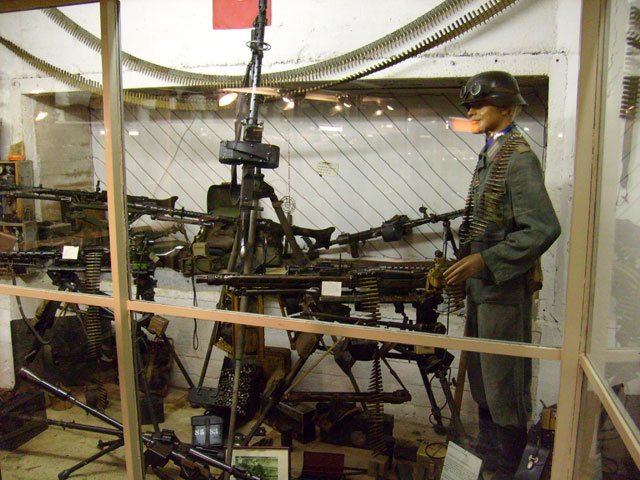
(Exhibition.)

(On the other hand: Fun stuff like this STD poster were also on
display...)
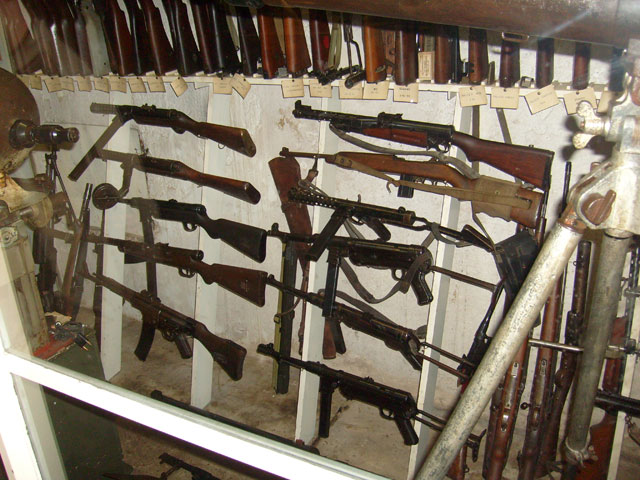
(Militaria everywhere...)
I went through all the rooms, but
was not impressed by the museum. Fr a gun nut this is probably
heaven, for the bunker nut this is more a bit weird. Uniform
fetishists would have a field day, but for me it was just too much
stuff that had nothing to do with the bunker. Too bad.

(Nice model of the bunker at war time.)
I left the bunker soon and watched
one of the huge and last remaining K5 cannons outside that is
still in good condition.
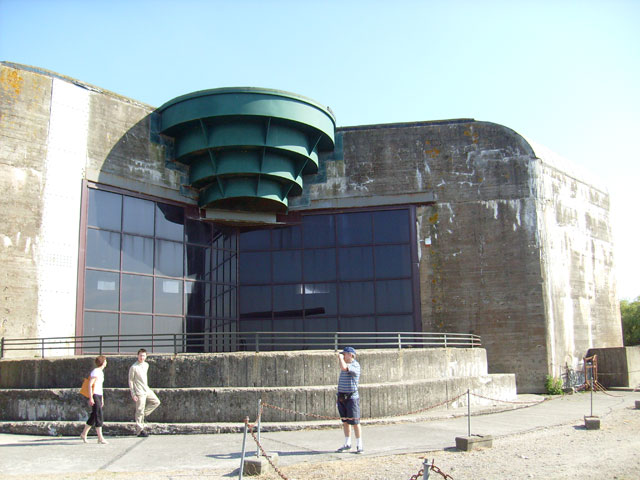
(The Bunker from the seaside.)
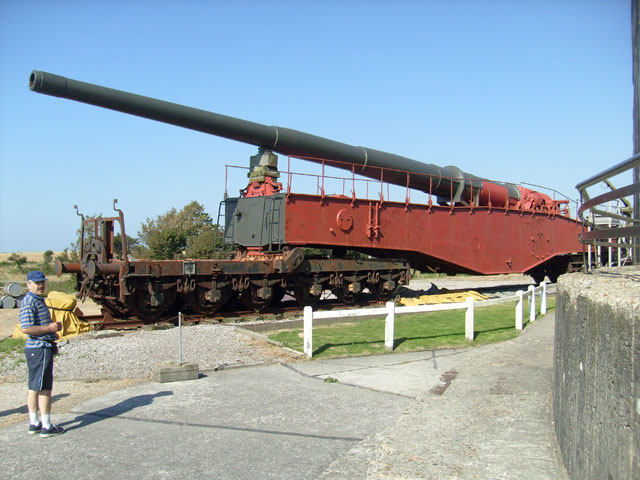
(K5 train gun.)
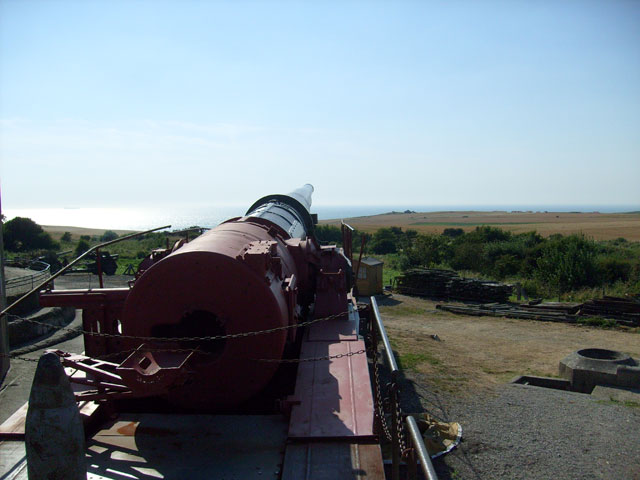
(K5 on top, pointing towards England.)
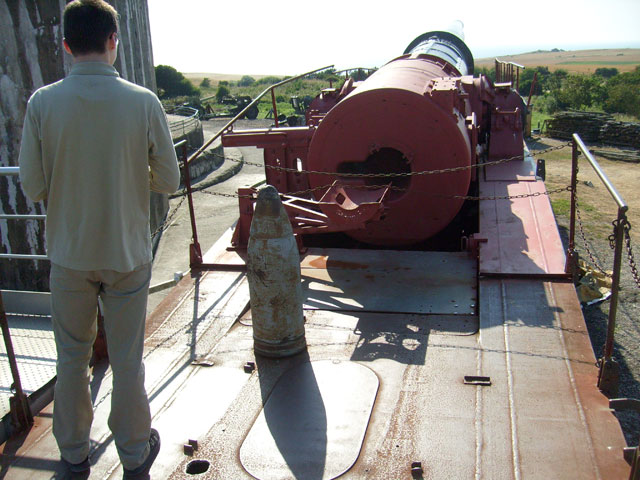
(K5 with artiellery shell and other tourist for scale)
Since it got pretty late nw and the
museum was about to close, I decided to not look for the other
towers nearby and instead head home. I had seen enough for the day
and the days before. A few more pictures and then I left to return
home. Which for once worked pretty wekll, only the constant
changing of freezer box and GPS unit was unnerving.
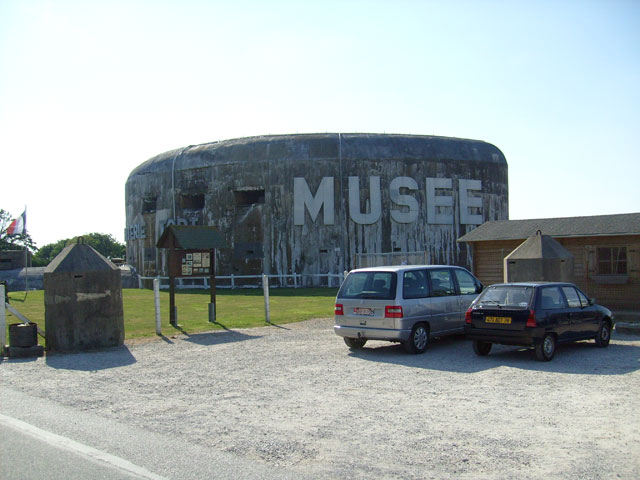
(Bunker last time from the outside.)
Shortly after midnight I was home
follwing a good six hours on the road. The drive went smooth and
without incidnets, light traffic - all in all an intersting, long
and intense bunker tour ended again. Could have been longer, since
there was so much more to see...
|